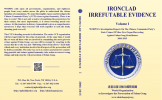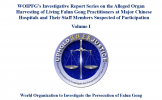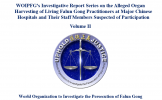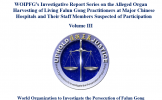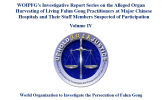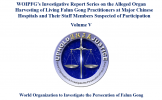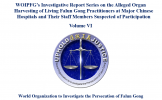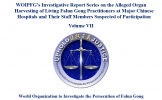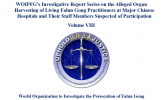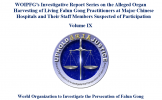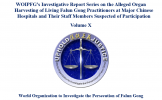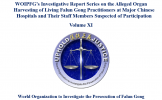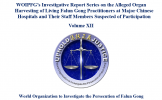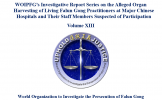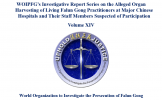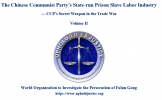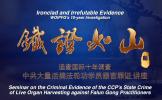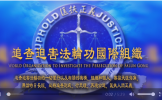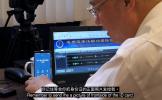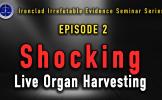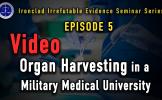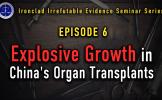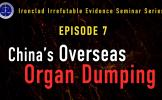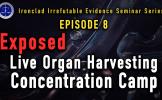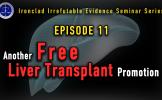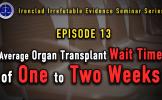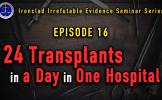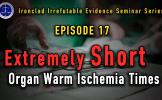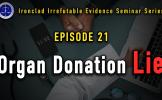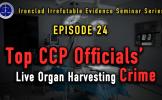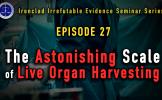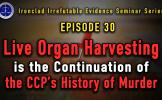THE FINAL HARVEST - Chapter 1: The Surge in Organ Transplants: Forced disappearances and Witness Testimonies
Download: A4 formaat Letter format
I. LANDSCAPE
II. THE INITIAL SURGE
III. CODES INSTEAD OF NAMES
IV. LAOGAI SYSTEM NUMBERS
V. EARLY INCIDENTS OF LIVE ORGAN HARVESTING
VI. MACRO HARVESTING TRAJECTORIES
VII. MICRO HARVESTING TRAJECTORIES
VIII. ANOMALIES IN CHINA’S ORGAN TRANSPLANT INDUSTRY
IX. FATAL FLAWS IN THE OFFICIAL EXPLANATION
X. CHAPTER CONCLUSIONS
Summary: This chapter reviews the disappearance of hundreds of thousands of Falun Gong practitioners beginning in 1999, and traces the explosive growth in organ transplantation in China’s medical system
I. LANDSCAPE
Since the beginning of this century, aging populations around the world have looked at the abundance of available organs in China as a sort of medical miracle. In their home country, they might face death by organ failure while waiting a year or two for a compatible donor: In China, hospitals openly advertised a tissue-matching organ within two weeks. While it was increasingly well-understood in international transplant circles that these organs were coming from executed prisoners, by the end of 2005, China had attracted foreigners, so-called “transplant tourists” from every continent on earth.
After the first allegations that the Chinese communist regime was harvesting organs from living Falun Gong practitioners were published in March 2006, transplant tourism did not come to a halt, but many operations went underground. Subsequently, WOIPFG, along with others in the international community, began an investigation into organ harvesting that is now in its ninth year, and has released more than 40 investigative reports on the CCP’s suspected involvement in organ harvesting from living Falun Gong practitioners.
As the investigation proceeded, WOIPFG investigators converged around the theory that the Falun Gong petitioners who did not report their names when being illegally detained were being secretly imprisoned and coded as living organ donors.
II. THE INITIAL SURGE
The year 2000 marked a watershed in China’s organ transplant industry. Hospitals across China, large and small, began to provide the facilities and the surgical teams that would culminate in the industries’ explosive growth. Even some small-scale hospitals or specialized clinics, which lacked the proper qualifications to perform organ transplants, began performing organ extractions and transplants. At its peak, nearly 1,000 hospitals would be performing organ transplant operations.
Six months earlier, in the summer of 1999, Beijing had made the decision to outlaw a widespread spiritual practice known as Falun Gong (or Falun Dafa). According to the CCP Public Security Department’s investigations, starting from May 1992 until July 1999, the number of Falun Gong practitioners had grown from a handful of people to somewhere between 70 million and 100 million practitioners[1]. From the CCP perspective, this was a significant milestone; although Falun Gong was widely perceived, even in Chinese Communist Party circles, as a non-violent movement which stressed the ethical principles of truthfulness, compassion and forbearance, the number of practitioners now outnumbered the 65 million members of the Chinese Communist Party. Under instructions from former CCP head Jiang Zemin, a comprehensive persecution against Falun Gong practitioners – waged in the state-controlled media and in the streets themselves - began on July 20, 1999.
In response, millions of Falun Gong practitioners traveled to Beijing to publicly appeal for an end to the repression. Initially, in the late summer and early autumn of 1999, most of the practitioners were rounded up and, following a relatively short detention, forcibly taken back to their homes. Yet upon their return, the practitioner’s families – regardless of their relationship to the Falun Gong practice - were often included in the ever-widening dragnet. Unemployment, school dismissals, and homelessness followed. At the same time, the first deaths of practitioners in custody were emerging across China.
A second surge of Falun Gong practitioners came to Beijing to appeal in 2000 to 2001. To avoid implicating their families and workplaces in a persecution that had no apparent legal restraints and was becoming increasingly violent, many now refused to reveal their names or other personal information to the police. The numbers were extraordinary; according to the Beijing Public Security Bureau’s internal information, as of April 2001, the number of Falun Gong practitioners who were arrested when petitioning in Beijing and had their names registered by the police, had reached fully 830,000[2]. By the end of 2001, the end of the peak period, the Beijing Public Security Bureau, employing the increased numbers of steamed buns that had been consumed, estimated that there had been approximately one million Falun Gong in Beijing on any given day.[3] It may seem odd to use food consumption as a benchmark, but this may indicate that the Public Security Bureau was no longer expected to keep careful arrest records. As many of these “nameless” practitioners could not be registered or sent back home, they were promptly transported from short-term detention centers into the Laogai System (labor camps, prisons, “black jails,” psychiatric wards, and long-term detention centers). Yet the CCP’s prisons and labor camps across China were already filled to capacity. As a result, the CCP transferred many of the nameless Falun Gong practitioners from the existing Laogai System into little-known underground prisons, labor camps and specialized concentration camps in remote areas[4]. In this way, several hundred thousand Falun Gong practitioners (mainly from Northeast China, North China and rural China) simply disappeared from any existing record.
It was not until years later that the forced disappearance of hundreds of thousands of Falun Gong practitioners was correlated to the new-found abundance of healthy organs available upon demand for organ transplants. In March 2006, a former surgeon’s wife, a veteran military doctor from Shenyang Military Region and other informants began to emerge, testifying that the CCP was harvesting organs from living Falun Gong practitioners on a significant scale. As a result, Canadian human rights lawyer David Matas, former Canadian MP David Kilgour, independent investigator Ethan Gutmann and others, joined the ranks of those who have critically examined these accusations. Collectively, the unanimous assumption of these investigators and WOIPFG is that the multitudes of nameless practitioners comprises both a stockpile and a continuing supply-line for the majority of the live donors that fuels China’s organ transplant industry today.[5]
III. CODES INSTEAD OF NAMES
We spoke with Chen Qiang, a kidney broker for People's Liberation Army (PLA) No. 307 Hospital in Fengtai District, Beijing. He stated that “they could just record code numbers” for nameless practitioners and that government officials and the prison system worked together in the trafficking of organs from Falun Gong practitioners, “like a coordinated supply line.” He also claimed to have materials that could confirm that the supplied organs were from Falun Dafa practitioners.[6]
(Download record:MP3)
Following are excerpts from the phone conversation between one WOIPFG investigator and Chen Qiang, a kidney broker for PLA No. 307 Hospital in Beijing. (A: Investigator, B: Chen Qiang)
B: Hello.
A: Hello, is this Xiao Chen?
B: Hello.
A: Is this Chen Qiang?
B: Yes, this is. Speak.
A: Hello. Last time I talked to you about contacting the kidney supply sources. How is it going?
B: You meant that, contacting the prison, or “that something”?
A: Yes, the source of Falun Gong practitioners, I meant. …
B: I’ve heard it’s now very strict.
A: Where did you get it before?
B: It was from Xichen (A place in Beijing).
A: Xichen, you now--- By the way, how could you be so sure he (the source) was a Falun Gong practitioner? Did you find out for sure?
B: How to positively identify a Falun Gong practitioner, well, when the time comes --- when the time comes, then on our side, our boss will have people show you some information, you know. He will show you the information and data. You can rest assured. We have connections with the government officials, as well. There are connections to high ranking officials. You know, I will show you such materials even if you don't ask me for them. You know.
A: OK. Ah… There is one more thing that I don't quite understand. That is to say, these people are detained in forced labor camps or prisons. Normally, I know that they are in the police stations…
B: Right now, there are fewer in the forced labor camps.
A: Really, where are they usually detained now?
B: Now they are all in prisons. Normally, they were sent away from Beijing, and from there transferred to other places.
A: I heard from others that, several years ago, they arrested many Falun Gong practitioners, who did not give their names after they were arrested, so they have detained quite a few. They have detained some of them underground. Some of the places were neither a prison nor a labor camp…
B: You are talking about what was going on around 2003. I know exactly what you are talking about. They started to not reveal their name in 2003. You see, starting from now, the Falun Gong (practitioners) are like that…so you have to allocate some from the 2003 files, you know.
A: Oh, so there were more cases in around 2003?
B: Of course. There were tons of Falun Gong (practitioners) on file around 2003.
A: You see, the 50,000 yuan as mentioned before is no problem. I tell you, I will give you 20,000 yuan extra to make you feel at ease. Later, you just tell me how much money you spent, you can just tell me an amount. I will feel more at ease.
B: This thing, I also need to use contacts to find it for you. The money they ask, I think it will be around 200,000 yuan, you know.
A: Yes.
B: Falun Gong---- Last time I made some inquiries by calling around … Later I contacted [the labor camp or prison officials] by phone. I asked my boss to call him [the official], and he [that official] said they would obtain the organs from “inside [the labor camps or prisons].”
A: Oh.
B: Now [the Falun Gong practitioners] have all been transferred to remote prisons. They [the officials] need to get the organs from there; that takes money. The majority of the money must be paid to people over there, you know.
A: Yes. You know that several years ago, they secretly detained many Falun Gong practitioners, who went to appeal but did not provide their names. There were no records, no registrations.
B: Yes, it is quite normal, you know … If the Falun Gong practitioner did not give his name, he would be assigned a code number, you understand?
A: Yes.
B: If they could not find out their real names, they could just record code numbers, you know.
A: Oh.
B: And also according to their fingerprints, you know, things are like this way now. In this society, if one doesn’t have, doesn’t have [some power and authority], he cannot do such things, especially these kinds of things, you know.
A: Yes.
B: After such a thing is done, I tell you. It is not that I want to tell you something. Hum, specific details such as the names of some people, I cannot tell you, you know.
A: Yes.
B: Like our boss, like the connections to the detention centers, I cannot tell you. Under these circumstances, I cannot talk casually. How can it be casual? We have the connections. Since we are doing this business, we have people in every department. How can you get it done without connections?
A: Yes. I am just…
B: Such an operation is like a coordinated supply line, you know.
A: Right.
IV. LAOGAI SYSTEM NUMBERS
Mainland China’s Fazhi Wanbao (Legal Evening News in English) reviewed the CCP’s “re-education through forced labor” system in an article on November 16, 2013 entitled “The Largest Number of Inmates in Forced Labor Camps Reached 300,000”, before labor camps were abolished at the end of that same year. [7]According to the report, after the 1990s, the number of inmates in the CCP’s labor camps rose year after year and reached a peak of 300,000 per year. Although it began to decline in 2006, there were still 90,000 inmates in 2012. The period of time, “in which there were up to 300,000 inmates per year”, mentioned by the Legal Evening News article was between 2000 and 2006.
This is the time period when the number of Falun Gong practitioners being held by the CCP was at its highest point. A rough calculation of 300,000 people per year, from 2000 to 2006, suggests that the CCP held approximately 2.1 million practitioners in labor camps. In addition, the US government mentioned in its 2008 Religious Freedom Report that more than half of the inmates in China’s labor camps were Falun Gong. [8] Based on this, during the six years from 2000 to 2006, approximately 1.05 million practitioners were detained in labor camps. This calculation happens to concur with Ethan Gutmann’s estimate (even though it was based on a survey method using a refugee sample of 50 individuals), that 1 million to 500,000 Falun Gong are incarcerated in the Laogai System at any given time, and 1.2 to 2.6 million were in the Laogai System from 2000 to 2008. In summary, we believe that during the 14 years between 1999 and 2013, up to several million Falun Dafa cultivators have been imprisoned in the Laogai System by the CCP.
V. EARLY INCIDENTS OF LIVE ORGAN HARVESTING
1) “Rescued after death”[9]
Zhao Yingqi was a 59-year-old worker of the South Fangezhuang Mine Management Section in Guye District of Tangshan City. Refusing to reject the practice of Falun Gong, Zhao was imprisoned at the Lotus Pit Forced Labor Camp in Tangshan on Nov. 20, 2002, and died 40 days later. When his family member saw the corpse, his skull was caved in, his eyes were wide open, there were bloodstains from his right mouth corner to his ear, and his hands and nails were dark purple extending all the way to the back and neck. A piece of flesh was missing from his right rib area, and his deflated abdomen was filled with water.
At 7pm on Dec. 30, the hospital informed his family of his death and put him in a mortuary. His wife was forbidden to wash his dead body and dress him the last time. The death notice was incomprehensible; “8:02 pm, Jan. 2, 2003.” In addition, a temporary doctor's note showed that on Jan. 1, 2003, Zhao had somehow accrued a “301 Military Hospital” expert consultation fee of 1000 yuan RMB (301 Military Hospital has since become notorious as a Falun Gong harvesting center). The hospital also charged his family over 10000 yuan RMB for medical expenses and 3090 yuan RMB for a senior cadre settlement fee two days after Mr. Zhao’s death. When questioned by Mr. Zhao’s family member who the senior cadre was, the hospital couldn't hide the whole truth anymore: "Well, the forced labor camp has to spend the money, because city Party secretary Chen Man had issued an order in person to rescue at all costs."
Zhao Yingqi was put in the mortuary on Dec. 30, 2002. Yet it is far from clear that he was actually dead at the time. Two days later, what was the so-called treatment that the 301 Military Hospital expert provided for Mr. Zhao and the senior cadre whom the city Party secretary Chen Man personally ordered “to rescue at all costs”?
2) “Forcibly cremated”
33-year-old Chen Aizhong was arrested when he went to Beijing to appeal for Falun Gong on New Year's Day in 2001. On Sep.12, Chen, who had lost the use of his hands and legs from torture, was illegally sentenced to three years of forced labor. He was secretly detained at the Lotus Pit Forced Labor Camp in Tangshan. On the 9th day, during force feeding, his heart suddenly stopped beating. He was sent to Tangshan People's Hospital and died there.
When his eldest sister Chen Shulan saw her brother’s supposedly “cleaned up” corpse in the mortuary, she noticed that he had bloodstains on his lip, his ears were swollen and were dark purple in hue, and his right ear hole was full of blood. When nobody was looking, she opened his shirt and saw an over 10cm long wound on his left chest. There was also uniform bruising extending from his shoulders all the way down his back. Chen Shulan asked for a forensic post-mortem examination including photographs and demanded to see her brother's detailed death report. While Chen Shulan was arguing that these requests had to be met before she signed any documents, Chen Aizhong's corpse was secretly cremated. The family received no remains.
VI. MACRO HARVESTING TRAJECTORIES
In 2000, as the mass incarceration of Falun Gong practitioners began, the organ transplant industry in mainland China entered a remarkable period of exponential growth. An article entitled “The Maze of Organ Donation: Only Organs are Visible, but not Donors” was published in the March 2010 issue of Southern Weekend. The “year 2000 was a watershed in China’s organ transplant industry”, the article states. “In 2000, the number of liver transplants in the entire country increased by 10 times in comparison with the number in 1999; and in 2005, that number tripled.” [10] At the same time, the number of hospitals engaged in performing liver transplants drastically increased from 19 in 1999 to more than 500 in April 2006. (By contrast, in the United States, the country with the most developed organ transplant industry in the world, only approximately 100 hospitals can perform liver transplants, and the number of hospitals that perform kidney transplants is no more than 200.) There were only a mere 100 or so liver transplant cases performed in the 20 plus years prior to 1999 in mainland China. By contrast, from January 1, 2005 to June 24, 2006, there were 5,644 recorded cases of liver transplantation in China[11]. Even within the one-year period from June 24, 2006 to June 24, 2007, while the medical world was fully aware of the allegations of the CCP harvesting organs from Falun Gong practitioners, there were still 4,267 cases of liver transplantation performed in mainland China.[12]
VII. MICRO HARVESTING TRAJECTORIES
The First Affiliated Hospital of Zhejiang University School of Medicine completed two cases of orthotropic liver transplantation from 1993 to 1997. [13] After 1999, the number of transplants dramatically increased. As of July 8, 2014, the hospital had performed 1521 cases of liver transplantation.[14] From July 1977 to December 1999, the hospital performed 898 cases of kidney transplants, with an average of 40 cases per year.[15] As of May 2012, the hospital had performed a total number of more than 3,300 cases of renal transplantation. Currently, it performs 280 cases of kidney transplant per year, approximately seven times the number of kidney transplants prior to 1999.[16]
In May 1994, Shen Zhongyang presided over the first liver transplant operation performed in Tianjin First Central Hospital. Within 3-5 years’ time, the hospital completed 5-8 cases of liver transplantation.[17] After 1999, the number of liver transplants increased rapidly and, as of 2004, Tianjin First Central Hospital’s Oriental Organ Transplant Center has performed 2,248 cases of liver transplantation. Every year, it performs an average of more than 300 cases of kidney transplantation and an average of 600 cases of liver transplantation. Tianjin First Central Hospital’s transplant department has also assisted nearly 47 medical institutions in 16 provinces to perform liver transplants and has assisted other hospitals to perform nearly 300 liver transplants.[18]
From 1978 to June 2000, the Shanghai First People’s Hospital performed 1,120 cases of renal transplantation, with an average of 50 kidney transplant operations per year[19]. From 2001 to the end of 2005, the hospital performed a total of 767 cases of kidney transplantation, 456 cases of liver transplantation and a total of 1,501 cases of bone marrow, heart, lung, liver-kidney, pancreas-kidney and cornea transplantation[20]. It performs 153 cases of kidney transplantation on average per year.
Zhujiang Hospital of Southern Medical University performed 1,030 cases of renal transplantation from June 1990 to February 2000, with an annual average of 100 cases.[21] From June 2000 to April 2001, the hospital performed 204 cases of kidney transplantation.[22] From 2000 to January 2003, the hospital completed a total of 628 cases of kidney transplantation in almost three years, with an annual average of more than 200 cases.[23]
Fuzhou General Hospital of Nanjing Military Region performed 808 cases of renal transplantation from December 1979 to September 1998, with an annual average of 39 cases.[24] From January 2000 to December 2004, in less than five years, the hospital performed 877 cases of renal transplantation, with an annual average of 175 cases.[25]
Xinqiao Hospital of the Third Military Medical University, from 1978 to 1984, performed 84 cases of renal transplantation, with an annual average of 14 cases.[26] From January 2003 to August 2006, the hospital performed 585 cases of first-time renal transplantation for patients aged 20 to 50 years, excluding the elderly patients and renal retransplantation patients.[27] The annual average is just over 159 cases.
The PLA General Hospital, from October 1977 to December 31, 1998, performed 1,003 cases of renal transplantation, with an annual average of 47 cases.[28] From January 1999 to December 2004, the hospital performed 1,034 cases of kidney transplantation, with an annual average of 172 cases.[29]
Southern Medical University’s Nanfang Hospital, from 1978 to 2001, performed a total of 2,123 kidney transplants, with an annual average of more than 90 cases.[30] From 2002 to July 2009, the hospital performed at least 1,677 cases of renal transplantation, with an annual average of more than 200 cases.[31]
Affiliated Changzheng Hospital of Second Military Medical University, from June 1978 to February 1998, performed 1524/1604 cases of allogeneic kidney transplantation, with an annual average of 80 cases.[32] From March 1999 to December 2002, the hospital performed 680 cases of renal transplantation, with an annual average of 180 cases.[33]
Since 1999, many hospitals or medical departments, which lacked the technical qualifications and permissions to perform organ transplants, were quickly converted into organ transplant centers and labs for tissue-matching, suggesting a “gold rush” pattern of medical investment. The dates and basic information of some of these newly founded medical units are presented in the table below.
Table 1 Overview of “Gold Rush” Organ Transplant Centers and Tissue Typing Centers
|
Hospital |
Overview |
|
The Ministry of Health Forensic Pathology Key Laboratory |
Established in October 1999 at Xi’an Jiaotong University’s Forensic Department, with the consent of the Ministry of Health’s Department of Medical Science, Technology and Education. Key laboratory co-founded by the Ministry of Health, Ministry of Public Security and the Supreme People’s Court. Claims “its research in the fields of organ transplant and tissue typing has reached an advanced international level.[34]” |
|
The PLA No.309 Hospital |
Established in April 2002. The Organ Transplant Center of the PLA No. 309 Hospital jointly founded by the Departments of Urology, Hepatobiliary Surgery and Cardiothoracic Surgery. In August 2005, Nephrology and Hematology Departments merged into the transplant center. Officially designated as the “Organ Transplant Center of the PLA” by the Health Department of the PLA’s General Logistics Department in March 2006. Renamed “Organ Transplant Research Institute of the PLA” by the Health Department of the PLA’s General Logistics Department in 2011. As the hospital’s key revenue center, the Organ Transplant Center saw an increase in its gross revenue from 30 million yuan in 2006 to 230 million yuan in 2010 - an eightfold increase in five years.[35] |
|
The PLA Second Artillery General Hospital |
A Liver Transplant Center was established in the PLA Second Artillery General Hospital in July 2004.[36] |
|
The General Hospital of Beijing Military Region |
The hospital’s Hepatobiliary Surgery Department and Liver Transplant Center started clinical liver transplants in 1999. The hospital claims that its liver transplant surgeries are now routine. Hepatobiliary Surgery Department claims to have established a fast and unobstructed channel to procure donor livers, not only from Beijing and its surrounding areas, but also from other provinces and cities without delay.[37] |
|
The PLA No. 302 Hospital |
A Liver Transplant Center was established in the PLA No. 302 Hospital in 2005.[38] |
|
The PLA No. 307 Hospital |
A Kidney Transplant Center was established in the PLA No. 307 Hospital in 2000.[39] |
|
General Hospital of Chinese People's Armed Police Forces |
Approved by the General Logistics Department of the Armed Police Forces, an Organ Transplant Research Center in the General Hospital of Armed Police Forces was established in April 2002.[40] |
|
Affiliated Beijing You’an Hospital of Capital Medical University |
Beijing You’an Hospital, affiliated with Capital Medical University, established a Liver Transplant Center in March 2003. In August 2004, the Sino-US Cooperative Center for Liver Transplantation was jointly set up by the hospital with the Starzl Organ Transplant Center of the University of Pittsburgh.[41] |
|
Peking University People’s Hospital |
Peking University Institute of Organ Transplantation, (formerly named Organ Transplant Center at Peking University), established in October 2001 under the personal guidance of Han Qide, Vice Chairman of the standing committee of the11th National People’s Congress.[42] |
|
Third Hospital of Peking University |
Organ Transplant Center in the Third Hospital of Peking University established in October 2001.[43] |
|
Haidian Hospital in Beijing |
Organ Transplant Center in Haidian Hospital established in November 2003.[44] |
|
Zhongshan Hospital, Fudan University |
Established October 30, 2001.[45] The Zhongshan Hospital Organ Transplant Center performs more than 100 organ transplants every year, with an annual increase of 50%. On December 8, 2003, a Collaborating Centre was established jointly by the Organ Transplant Center of Zhongshan Hospital, Fudan University, and Thomas E. Starzl Transplantation Institute of the University of Pittsburgh in the US, the world's largest organ transplant organization.[46] |
|
Shanghai First People’s Hospital (aka Affiliated First People’s Hospital of Shanghai Jiaotong University) |
Shanghai Clinical Center for Organ Transplantation was established in August 2001, affiliated with the First People’s Hospital in Shanghai. The Center was founded by combining “Shanghai Organ Transplant Research Center” and “Shanghai Tissue Typing Center.” Initially relying on kidney transplants, the hospital currently claims to have performed transplants of the heart, liver, and combined transplants of liver-kidney, pancreas-kidney, kidney-adult pancreas islet cell and other substantive transplants including corneas, allogeneic finger, fetal pancreas islet cell, bone marrow, peripheral blood stem cell and cord blood stem cell.[47] |
|
Shanghai Ruijin Hospital |
Organ Transplant Center in Shanghai Ruijin Hospital was established in 2002.[48] |
|
Shanghai Thoracic Hospital, affiliated with Shanghai Jiaotong University |
In 2008, Shanghai Thoracic Hospital set up a “Lung Transplant Clinical Center”. The center provides technical support to many domestic hospitals in carrying out clinical lung transplantation.[49] |
|
Tianjin First Central Hospital |
Tianjin First Central Hospital Organ Transplant Center created in 1998 by Shen Zhongyang. Tianjin Institute of Organ Transplantation established in 2002. Center contains transplant surgery, transplantation medicine, transplant ICU, transplant follow-up, anesthesia, imaging, pathology, ultrasound, transplant laboratories and other departments. Center is able to simultaneously carry out liver transplantation, kidney transplantation, pancreas transplantation, small intestine transplantation and heart transplantation. The largest professional transplant organization in China and the largest organ transplant center in Asia.[50] |
|
Affiliated Southwest Hospital of the Third Military Medical University |
Southwest Hospital started clinical liver transplantation in May 1999. Designated as Key Laboratory of the PLA for liver transplants in 2001. International Collaboration Center was established in 2004 with the cooperation of Southwest Hepatobiliary Surgery Hospital and Thomas E. Starzl Transplantation Institute of the University of Pittsburgh in the US.[51] |
|
The First Affiliated Hospital of Wenzhou Medical University |
The Organ Transplant Division[52] and the Transplant Matching Division[53] were both established in 1999. |
|
Transplantation Medical Engineering Research Center of the Ministry of Health |
Approved by the Ministry of Health, the Transplantation Medical Engineering Technology Research Center was formally established in the Third Xiangya Hospital, Central South University, in 2005. During the first three years of its operation, the center successfully carried out hundreds of cases of piggyback liver transplantation and over 1,000 cases of kidney transplantation, as well as multi-organ combined transplants of liver-kidney, liver-pancreas, liver-intestine and pancreas-kidney. Also performed are spleen transplantation, pancreas transplantation, heart transplantation, split liver transplantation and liver transplantation between relatives, and thyroid and parathyroid transplant, as well as transplantation of cells from liver, spleen and pancreas.[54] |
|
Multi-organ Combined Transplantation Research Key Laboratory of the Ministry of Health |
The Key Laboratory for Multi-organ Combined Transplantation Research, under the Ministry of Health, was established in March 2001. Located in the First Affiliated Hospital of Zhejiang University School of Medicine, the laboratory has built up dedicated clinical sites for liver transplantation, kidney transplantation, bone marrow transplantation, and heart and lung transplantation. Their multi-organ combined transplantation project has been recommended by the Ministry of Health and provides technical support to more than 20 province and municipal hospitals.[55] |
|
Changzheng Hospital, affiliated with Second Military Medical University of the PLA |
The Organ Transplant Center in the Changzheng Hospital was established in early 2003 by combining the Department of Urology and General Surgery Liver Transplantation Department. On December 17, 2003, the center was approved by General Logistics Department of the PLA to become the first organ transplant institute of the PLA.[56] |
VIII. ANOMALIES IN CHINA’S ORGAN TRANSPLANT INDUSTRY
Extremely short donor organ wait times: According to the data from the US Department of Health and Human Services, the average U.S. wait time for donor livers is two years, and the average wait time for kidneys is three years.[57] However, a number of hospitals in China said that their patients’ donor wait time is so short, that the wait time is measured in weeks.
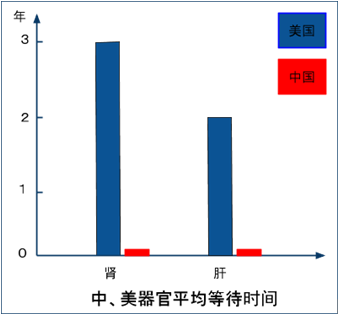
Figure1 the average organ wait time in China and USA
The abundance of human organs has resulted in tens of thousands of foreigners traveling to China for organ transplant tourism: According to a report in the Sanlian Life Week magazine in 2004, most Chinese organ transplant patients “have their own enterprises and run their own businesses” and there are also some, who “have positions”. The report also said that in just a few years, tens of thousands of overseas organ transplant patients have started to come to China, launching a type of “organ transplant tourism”. This article described the “grand spectacles” of organ transplant tourism: “In addition to the Koreans, the Tianjin First Central Hospital (aka. the Oriental Organ Transplant Center) also has patients from nearly 20 Asian countries and regions, including Japan, Malaysia, Egypt, Pakistan, India, Saudi Arabia, Oman, Hong Kong, Macao, Taiwan and others. On the 4th floor of the hospital, one can often see Arabs with turbans and in robes. The cafe at the center of the sick ward seems to have become an “international conference club”, with patients of different colors and races sharing their experiences in receiving medical treatment.[58]
The donors had excellent health when they were still alive, and the vast majority of them were young men with “no history of alcohol abuse” or any other bad habits: The medical papers’ descriptions of these “donors” identified them as having “no history of long-term medication”, “no Hepatitis B, Hepatitis C, malignant tumor or chronic illnesses”, “no history of alcohol abuse, diabetes or other illnesses” and “no fatty livers”.[59] And the health conditions of these “donors” from many provinces’ hospitals were roughly equivalent.
Table 2 36 Examples of “Donors” with Perfect Health
|
Hospital Name |
Time Period of Transplant |
Description of “Donors” |
|
1. Dongguan (city) Taiping People’s Hospital |
2002/8 – 2005/8 |
Implementation of 350 kidney transplants, including 90 combined liver-kidney extractions and 260 liver extractions. “Donors” were 20 to 30 years of age, liver function tests normal, HBsAg. HBeAg. HBeAb. HCV-Ab. HEV-Ab. HIV-Ab. RPR. TPPA tested negative.[60] |
|
2. Beijing Military Region General Hospital |
2005/ 4 – 2007/7 |
Implementation of 30 liver transplants, combined liver-kidney extraction from cadavers. “Donors” were 18 to 42 years of age, Hepatitis B, Syphilis, HIV tested negative, no Tuberculosis, no malignant tumor, no chronic illnesses. The warm ischemia time of "donor livers" was 2~7min, average time was 4.6min.[61] |
|
3. Navy General Hospital
|
2005/3- 2005/8 |
Implementation of 3 heart transplants, “donors” were brain-dead, ages 31, 22 and 28, no history of cardiovascular diseases and any other key organ diseases.[62]
|
|
4. Capital Medical University Affiliated Anzhen Hospital |
1992/4 – 2006/4 |
51 heart transplants, all male, ages 21 to 43, no history of cardiovascular diseases and any other key organ diseases. Transportation took less than 1 hour. (In all 51 cases, the distance between where hearts were extracted and where transplantations were conducted was less than 1 hour.)[63] |
|
5. Qianfoshan Hospital, Shandong province |
2002/1 – 2005/1 |
44 liver transplants, “donors” had no Hepatitis B, Hepatitis C, HIV, Syphilis and other blood transmitted diseases. The warm ischemia time was 5 to 10 minutes, averaging 5.6 minutes.[64] |
|
2003/3 - 2012/10 |
25 heart extractions and transplants, “donors” were 20 to 35 years of age, with no history of cardiovascular diseases.[65] |
|
|
6. Shandong Provincial Hospital
|
2005/1-2008/12 |
6 combined liver-kidney transplants, “donors” were 19 to 40 years of age, averaging 28. No history of alcoholic use, no malignant tumors, no infectious diseases, no diabetes, liver and kidney function normal, HIV tested negative. Warm ischemia time was 2.5 to 4 minutes.[66] |
|
7. Weifang People’s Hospital
|
2001/3 – 2006/8 |
9 liver transplants, cadaveric livers from healthy young people, liver function normal, five tests of Hepatitis B negative, fast extraction method was used, warm ischemia time was 5 to 8 minutes.[67] |
|
8. Affiliated Hospital of Binzhou Medical College, Shandong Province |
2004/10 /22 |
One lung transplant, “donor” was male, no history of cardiovascular and lung diseases, no history of smoking, warm ischemia time was 2 minutes.[68] |
|
9. Jinan No.4 People’s Hospital & Fujian Medical University Affiliated Xiehe Hospital |
2006/7/1, 2006/8/6 |
Jointly conducted 2 heart extractions and transplants, “donors” were 38 and 26, and had always been in good health.[69]
|
|
10. Jining Medical College Affiliated Hospital, Shandong Province |
2002/12/13 |
One liver extraction and transplantation, “donor” was male, died of traumatic brain injury, in good health when alive, liver function normal, warm ischemia time was 4 minutes.[70] |
|
11. Jinan Central Hospital |
2002/8 |
One liver extraction and transplantation, “donor” was 25 years of age, no infectious diseases, no malignant tumors, and no liver diseases.[71] |
|
12. Fudan University Affiliated Zhongshan Hospital |
2000/5 – 2011/4 |
298 heart transplants, 291 cadaveric hearts, 7 cases of brain-dead donor hearts, ages 18 to 45, average age 26.8±4.5, 283 male and 15 female. All “donors” had no obvious history of cardiovascular diseases and other major organ diseases. Since 2007, 60 hearts were extracted after the hearts had stopped beating, and the rest were extracted while the hearts were beating.[72] |
|
13. Nanjing Military Region Fuzhou General Hospital
|
1999-2004 |
40 fast kidney-liver extractions and liver transplants, all 40 “donors” were male non-heart-beating cadavers, average age 27 (21 to 45 years of age). Liver function normal and HIV negative.[73] |
|
14. No.2 Affiliated Hospital, Haerbin Medical University |
2004/1 |
One heart transplant, “donor” was 37 years old and brain-dead, weighed 72kg, was in good health when alive, warm ischemia time was less than 5 minutes.[74] |
|
15. Wuxi People’s Hospital,Jiangsu Province
|
2002/9-2011/1 |
100 lung extractions and 101 lung transplants, “donors” had no history of primary heart disease, no history of lung diseases, no history of heart or lung surgery, no severe chest injury, no lung injury, no Aspiration pneumonia, no Suppurative disease, no malignant lesions, HIV and Hepatitis tested negative.[75] |
|
16. No.1 Affiliated Hospital, Nanjing Medical University |
2004/10-2006/4 |
117 liver transplants using cadaveric livers, “donors” had no liver diseases, no malignant tumors, no obvious Steatosis, Hepatitis B Serology tested negative.[76] |
|
17. No.1 Affiliated Hospital of Suzhou University
|
2000/8-2001/4 |
5 liver transplants and extractions, “donors” were 20 to 40 years of age, no infectious diseases, no malignant tumors, no chronic liver diseases. [77] |
|
2000-2006 |
6 heart extractions and transplants, “donors” were 25 to 37 years of age, no history of cardiovascular disease, lymphocyte cross matching negative, Cytomegalovirus, EB virus, Hepatitis virus, and HIV tested negative.[78] |
|
|
18. Nanjing Drum Tower Hospital
|
2004/6-2005/6 |
42 combined kidney-liver extractions, “donors” were 19 to 38 years of age, 40 were male, 2 were female, no infectious diseases, no kidney or liver diseases. [79] |
|
19. Zhenjiang No.1 People’s Hospital |
2005/4 - 2006/12 |
4 heart extractions and transplants, “donors” were male, ages 23 to 40, no history of cardiovascular and lung diseases, and no history of thoracic (chest) surgery.[80] |
|
20. The Second Hospital of Nanjing |
2004/3-2004/11 |
11 fast combined liver-kidney extractions, all “donors” were brain-dead, ages 18 to 36, no infectious diseases, no lung diseases, no liver diseases, no other serious illnesses. [81] |
|
21. Wuxi No.2 People’s Hospital
|
2000/12-2003/3 |
5 liver extractions and transplants, “donors” were brain-dead, healthy, young adult male. |
|
22. Xuzhou Medical College Affiliated Hospital
|
2002/4-2002/7 |
2 heart transplants, “donors” were male, ages 28 and 24, died of traumatic brain injury. “donors” had been in good health, Hepatitis B, Cytomegalovirus, EB virus tested negative.[83] |
|
23. The Second Hospital of Hebei Medical University |
2001/10-2002/10 |
5 liver transplants, all cadaveric livers, “donors” ages 20 to 40, no infectious diseases, no malignant tumor, no chronic diseases.[84] |
|
24. Second Xiangya Hospital of Central South University |
Until 2006 |
60 combined liver-kidney extractions from cadavers, 30 cases were non-heart-beating cadaver “donors,” 28 males, 2 females, 19 to 37 years of age, preoperative testing for immune system diseases and Hepatitis were negative, kidney and liver function normal.[85] |
|
25. Third Xiangya Hospital of Central South University |
2002/3-2005/12 |
107 liver extractions and transplants, low temperature perfusion to the organs during extraction, all “donors” were healthy.[86] |
|
2004/1-2008/6 |
91 liver extractions and transplants, “donors” were 19 to 55 years of age, averaging 29. 80 males, 11 females, preoperative testing of liver and kidney functions normal, virological examination also normal. Multi-organ fast extraction method was used.[87] |
|
|
2004/1-2006/7 |
64 liver extractions from non-heart-beating cadavers, “donors” ages 19 to 55 (average 32.5). Preoperative liver and kidney function testing normal, no fatty livers, Hepatitis C and HIV all tested negative.[88] |
|
|
26. China Medical University Affiliated No.1 Hospital
|
1995/5-2005/6 |
122 orthotopic liver transplants, 165 combined liver-kidney extractions, “donors” were all brain-dead, ages 20 to 54, 119 males, 3 females, preoperative HIV and Hepatitis testing negative, liver and kidney function normal. [89] |
|
27. The Fourth Military Medical University Affiliated No.1 Hospital Xijing Hospital
|
2001/1/26-2003/9/26 |
26 orthotopic heart transplants and extractions, “donors” were male, brain-dead, no history of cardiovascular diseases. [90] |
|
28. PLA 452 Hospital
|
2006/7-2009/10 |
164 kidney transplants and extractions, “donors” were 81 males, 1 female, ages 22 to 46, average 32.3, no Tuberculosis, no Hepatitis, no Syphilis, no HIV and other infectious diseases.[91] |
|
29. Sichuan Provincial People’s Hospital |
2007/8-2009/4 |
34 kidney transplants and extractions, “donors” were healthy, no high blood pressure, no cardiovascular disease, no Tuberculosis, no diabetes, no kidney and liver diseases.[92] |
|
30. The First Affiliated Hospital of Wenzhou Medical University
|
2001/3-2004/12 |
35 orthotopic liver transplants and extractions, all “donors” were brain-dead healthy adult, warm ischemia time was 3 to 7 minutes, average 4.4 minutes. [93] |
|
2003/2-2004/1 |
2 orthotopic heart transplants from cadaveric “donors,” all younger than 35 years of age, no history of cardiovascular diseases, no Hepatitis, no Tuberculosis, and other infectious diseases. [94] |
|
|
31. Shanxi Armed Police Corps Hospital, Armed Police Forces General Hospital |
2004/10-2006 |
12 liver transplants and extractions, all liver “donors” were male, died of traumatic brain injury. [95] |
|
32. Inner Mongolia Medical University Affiliated Hospital |
2003/8-2004/12 |
2 orthotopic heart transplants, “donors” were male, 31 and 42 years of age, brain-dead, in good health.[96] |
|
33. Dongguan People’s Hospital |
2003/4, 2003/12 |
4 orthotopic heart transplants, “donors” were male, brain-dead, ages 20 to 30, no history of cardiovascular diseases, warm ischemia time 0 to 3.5 minutes.[97] |
|
34. Foshan First People’s Hospital |
1999/12-2001/12 |
13 orthotopic liver transplants (including 1 secondary liver transplant) and extractions, “donors” ages 20 to 35, no infectious diseases, no malignant tumors, no chronic diseases.[98] |
|
35. Guangzhou Military Region Guangzhou General Hospital |
2007 |
50 combined liver-kidney extractions and transplants, “donors” had no infectious diseases including Hepatitis B, Hepatitis C, syphilis and HIV, and no liver and kidney diseases.[99] |
|
36. PLA 107 Hospital |
2003/1-2010/10 |
168 liver transplants, cadaveric livers, no malignant tumors, HIV, syphilis, Hepatitis C tested negative. 2 cases of surface antigen positive, rest were negative.[100] |
Sources: WOIPFG, 2016.
China’s public security and judicial systems are directly involved in organ transplantation and tissue typing: The Ministry of Health Forensic Pathology Key Laboratory established in October 1999 at Xi’an Jiaotong University’s Forensic Department was jointly founded by the Ministry of Health, the Ministry of Public Security and the Supreme People’s Court. On its website, the laboratory claims, “our research in organ transplant, tissue typing and other areas has reached an advanced international level”.[101] The forensic laboratory was supposed to provide material evidence for criminal cases. Instead it has become involved in organ matching for transplantation, which should be an exclusive function of the Ministry of Health. This has turned the Ministry of Public Security, which has been seizing and detaining a large number of Falun Gong practitioners, and the judicial system, which controls the issuance of death sentences and is capable of providing forged death sentence certificates, into partners in murdering people for organ transplants. In another example, Kunming Forensic Hospital in Yunnan Province also has a hemodialysis kidney transplant center, whose forensic evidence laboratory used to perform some paternity tests. However, in 2001, the laboratory started tissue typing for organ transplants. It claims to have “completed several thousand cases of tissue typing for organ transplants, from 2001 to 2008.[102]” And it has jointly performed 1,537 kidney transplants with Dongguan Taiping People’s Hospital’s Organ Transplant Center.[103]
The warm ischemia time is zero or extremely short, indicating that the donors were alive:
The warm ischemia time is the period of time from the moment when the donor stops supplying blood to the organ, to the start of cold perfusion. The shorter the warm ischemia time, the higher the organ quality, and the higher the organ transplant success rate. If an organ was excised from a cadaver, its warm ischemia time is generally very long. However, the vast majority of the organ warm ischemia times described in the research papers is extremely short. Below are a few examples:
- In the Affiliated Hospital of Nanjing Medical University, from 2005 to 2007, 112 donor livers’ warm ischemia times were between 0 and 10 minutes, with an average of 3.96 minutes.[104]
- In the PLA Second Artillery Force General Hospital, from 2004 to 2007, 103 donor livers from “healthy young people’s cadavers” actually had warm ischemia times of 0 to 5 minutes.[105]
- In the Second Military Medical University-affiliated Changzheng Hospital in Shanghai, from 2001 to 2004, 240 donor livers had warm ischemia times of 0 to 8 minutes.[106]
- In the Tianjin First Central Hospital, from 2003 to 2005, 200 donor livers excised from brain-dead non-heart-beating cadavers had warm ischemia times of less than 8 minutes[107]. This indicates that the entire liver excision process – i.e. the process of turning the “donors” from living human beings to “cadavers with no heartbeats” - was premeditated.
Table3 Selected Cases of Extremely Short Warm Ischemia Time
|
Hospital Name |
Time of Transplants |
Cases |
Warm ischemia Time of Removed Organs |
|
1.The Affiliated Union Hospital of Fujian Medical University |
August 1995 - October 2007 |
111 |
111 cases of donor heart evisceration, all donors were brain dead, aged at 25±7, no history of cardiovascular disease, warm ischemia time 0-15min[108]. |
|
2.Nanjing Drum Tower Hospital
|
January 1996 - March 2008 |
314 |
314 liver transplants implemented, warm ischemia time 0-2min[109]. |
|
3.No.1 Affiliated Hospital of Guangxi Medical University |
June 26, 1996 - June 2004 |
20 |
20 cases of fast simultaneous removal of multiple organs were implemented, with warm ischemia time 0-5min[110]. |
|
4. The PLA No. 309 Hospital |
2003-2009
|
162 |
162 liver transplants implemented, warm ischemia time 0-5min, average 2min[111]. |
|
5.Foshan City No.1 People’s Hospital |
March 2003 -December 2006 |
28 |
28 cases of removing livers from donors, who had no liver diseases, warm ischemia time 0-6min[112]. |
|
6.Guangzhou General Military Hospital |
July 2006 - May 2011 |
20 |
20 cases of removing organs from donors, warm ischemia time 0min[113]. |
|
7.Shanghai Ruijin Hospital |
June 2002 – September 2004 |
100 |
100 cases of removing livers from donors, cardiac arrest time 0-7min. No liver diseases at all, no malignant tumor, no obvious fatty degeneration, negative hepatitis B virus[114]. |
|
8. Wuxi City No.2 People’s Hospital |
December 25, 2000; January 30, 2002; March 13, 2002; September 28, 2002; March 24, 2003 |
5 |
5 liver transplants, donors were healthy men, brain dead, livers of good quality, warm ischemia time almost 0 min[115]. |
|
9. No.1 Affiliated Hospital of Wenzhou Medical Institute |
February 2003-April 2004 |
3 |
3 orthotopic heart transplants, donors were men, age of 18, 31, and 45, warm ischemia time 0 min[116]. |
|
10.The Affiliated Hospital of Nanjing Medical University |
March 2005 - November 2007 |
125 |
Among 125 liver transplants, 112 were from “deceased donors,” but their warm ischemia times were between 0-10 minutes, average 3.96 minutes[117]. |
|
11.No.2 Affiliated Hospital of Medical School of Zhejiang University |
August 31, 1999 - February 9, 2001 |
10 |
Conducted 10 liver transplants, all 10 donors were brain dead. Fast simultaneous removal of multiple organs was implemented. The warm ischemia time was 0-5 minutes, averaging 3.06 minutes[118]. |
|
12.The Affiliated Hospital of Jiangsu Nantong Medical Institute |
November 2000 - May 2003 |
4 |
4 orthotopic heart transplants, donors brain dead, 3 male, 1 female, heart function normal before death. The 4 donors were all cut open in chest immediately after brain death. Warm ischemia time was 0-2min, average 1min[119]. |
|
13.Nanjing Drum Tower Hospital, Jiangsu Province |
June 2004-June 2005 |
42 |
Obtained 42 donor livers, with warm ischemia time of 0-5min, brain dead, age of 19 to 38, no infectious diseases, no kidney or liver diseases[120]. |
|
14. No.2 Artillery General Hospital |
July 2004 - 2007 |
103 |
103 liver transplants, “all donors were healthy young people, 1 brain dead donor, 102 cadaveric donors with the same blood type as recipients,” but their warm ischemia times were only 0-5 min[121]. |
|
15.Shanghai Changzheng Hospital |
October 2001 – September 2004 |
240 |
240 liver transplants implemented, warm ischemia time 0-8 min[122]. |
|
16.Dongguan People’s Hospital, Guangdong Province
|
April 2003 and December 2003 |
4 |
4 orthotopic heart transplants, warm ischemia time 0-3.5 min[123]. |
|
17.The Affiliated Union Hospital of Fujian Medical University |
August 1995 – March 2009 |
96 |
96 orthotopic heart transplants, donors were brain dead, male, age of 20 to 45, warm ischemia time 0-15 min, cold ischemia time 50-235min[124]. |
|
18.South Hospital Affiliated to South Medical University |
April 5, 2000 |
1 |
1 orthotopic heart transplant, donor brain dead, male, donor and recipient of the same blood type, lymphocytotoxic crossmatch PRA < 1%, HLA half match, warm ischemia time 0 min, cold ischemia time 90min[125] |
|
19. The PLA No. 117 Hospital |
April 1989 – October 2002 |
294 |
294 cases of fast removal of both kidneys implemented, warm ischemia time 30s-10 min[126] |
|
20.The Affiliated Children’s Hospital of Beijing Military General Hospital |
September 2006 – August 2007 |
7 |
7 heart removal from donors for transplants, donors brain dead, warm ischemia time 1-10 min[127] |
|
21. Fudan University Affiliated Zhongshan Hospital |
January 2004 to August 2006 |
117 |
117 cases of fast removal of liver and kidney simultaneously from donors as soon as their heart arrest occurs. 109 male, 8 female, age of 18 to 47, with average of 28.6, warm ischemia time 1-5 min[128] |
|
22.South Hospital, South Medical University |
August 2004-December 2007 |
126 |
126 cases of fast removal of liver and kidney simultaneously. Warm ischemia time 1-8.5 min, average 4 min[129] |
|
23.No.1 Affiliated Hospital of China Medical University |
September 1999-September 2004 |
19 |
19 cases of simultaneous pancreas-kidney removal, donors all male, average age of 30, all serious brain damage, warm ischemia time 2.0±0.5 min[130] |
|
24.Shanghai No.1 People’s Hospital |
January 2001-September 2003 |
138 |
138 cases of simultaneous liver-kidney removal, medical staff from partner hospital removed 5 hearts and 3 lungs, warm ischemia time 2-5 min[131]. |
|
25. The PLA No. 81 Hospital |
April 2003- February 2008 |
68 |
68 cases of liver removal, warm ischemia time 2-5 min[132] |
|
26.Beijing Military General Hospital |
April 2005-July 2007 |
30 |
30 cases of orthotopic liver removal, warm ischemia time 2-7 min, average 4.6 min[133]. |
|
27. The PLA No. 401 Hospital |
September 2003-May 2004 |
34 |
34 cases of liver removal, warm ischemia time 2-9 min, average 5.1 min[134] |
|
28.The Affiliated Hospital of Binzhou Medical Institute |
October 22, 2004 |
1 |
1 single-lung removal, donor male, no lung disease, no history of cigarette smoking, warm ischemia time 2 min[135]. |
|
29.Shandong Province Hospital |
January 2005- December 2008 |
120 |
120 liver transplants implemented, 6 of the 120 were simultaneous liver-kidney transplants, donors age of 19-40, average 28, no history of alcohol drinking, no malignant tumor, no infection, no diabetes, normal function of liver and kidney, negative hepatitis B and HIV, warm ischemia time 2.5-4 min[136] |
|
30.Affiliated No.1 Hospital of National Sun Yat-sen University |
January 2006-January 2007 |
2 |
2 cases of heart and lung transplants performed, donors male, age of 28 and 32, brain dead, no heart disease or infectious diseases, warm ischemia time 2.5 min and 3 min[137] |
|
31.Anyang City Chinese Medicine Hospital |
January 2000-December 2004 |
36 |
36 cases of kidney removal, warm ischemia time 2-13 min[138] |
|
32.Jiujiang City No.1 People’s Hospital |
October 26, 2001 |
1 |
1 liver transplant implemented, donor was dead 2min before the liver removal[139]. |
|
33.Southwest Hospital Affiliated to No.3 Military Medical University |
June 26, 2000 |
1 |
1 case of simultaneous heart-kidney transplant, donor male, age 28, brain dead after serious damage, warm ischemia time 2min20s[140]. |
Sources: WOIPFG, 2016.
Corneal transplants all used fresh corneas excised from young adults that suffered “sudden deaths”: In China, no matter how large or small the hospitals are, or where they are located, as long as they perform corneal transplants, their medical papers on corneal transplants have surprisingly similar descriptions of the “donors.” The most frequently used term is “young adult that suffered sudden death”. Yet the corneas were usually harvested within 10 minutes to several hours after the donors’ deaths, and the transplants would take place 10 to 24 hours after the corneas were excised.
For example, the First Affiliated Hospital of Guangxi Medical University, from 1995 to 2005, used fresh corneal grafts from young adults who died sudden deaths in 216 transplant cases. All eyeball excisions were performed within one hour of the donors’ deaths.[141]
In 81 cases of corneal transplants performed by the Beijing PLA Air Force General Hospital from 2001 to 2005, the “donors” were 18 to 35 years of age, with no eye diseases, no vital organ illnesses and no infectious diseases. And their corneas were transparent. All eyeball excisions were performed 30 minutes to 6 hours after death. All corneal transplants were performed within 12 hours of the removal of the corneas.[142]
Henan Province’s Hospital of Occupational Diseases, from 2003 to 2007, performed 121 corneal transplants, in which the “donors” were young adults who died sudden deaths.[143]
In 119 corneal transplants performed at Anhui Armed Police Corps Hospital from 1999 to 2008, the “donors” were young adults who died sudden deaths. The corneas were excised within one to two hours after the donors’ deaths.[144].
In 73 corneal transplants performed at the First Affiliated Hospital of Kunming Medical University from 2006 to 2009, fresh cornea grafts were obtained from healthy young people who died sudden deaths. The time between their deaths and corneal excisions were 10 minutes to one hour.[145]
What were the causes behind the “sudden deaths” of such a large number of “young adults”? How were the various hospitals notified of the “sudden death”? How could the news of their “sudden deaths” be communicated to the various hospitals involved in extremely short times, so the hospital’s teams could manage to arrive at the scene of death in time to harvest “fresh” corneas? How did the hospitals find recipients and perform transplants within 10 to 24 hours?
Table 4 Suspiciously Similar Descriptions of Cornea “Donors”: “Sudden Death, Young Adults”
|
|
Hospital Name |
Time Period of Transplants |
No. of Corneal Transplants |
Description of “Donors” |
|
1 |
Central Hospital of Beijing Prison Administration Bureau & Beijing Tongren Hospital Eye Center |
1993 - 2005 |
27 cases (30 eyes) |
Deceased young adult male.[146] |
|
2 |
|
No description of time when transplant took place. The paper was submitted in Feb. 2002. |
45 cases |
All “Donors” died of sudden death, age 20-43, average age is 30.4+/-5.4. Donor eye was removed 30 minutes to 3 hours after death.[147] |
|
3 |
Qinghai University Affiliated Hospital |
2000/5 - 2004 |
13 cases |
“Donors” were young adults died of sudden death.[148] |
|
4 |
Affiliated Hospital of Zunyi Medical College, Guizhou Province |
2000/3- 2001/7 |
10 cases |
“Donors” were healthy young people, corneas were fresh, time between donors’ deaths and corneal transplants were less than 10 hours.[149] |
|
5 |
Kunming No.1 People’s Hospital, Yunnan province |
2006/6 - 2009/11 |
73 cases |
“Donors” were young healthy persons died of sudden death. [150] |
|
6 |
Mudanjiang Medical College Hongqi Hospital, Heilongjiang province |
Until 2009 |
34 cases (36 eyes) |
“Donors” were all healthy young people died of unnatural deaths, ages ranged from 18 to 40, all were male.[151] |
|
7 |
Ningbo Eye Hospital, Zhejiang province |
2001/2 – 2002/12 |
13 cases (18 eyes) |
Cadavers’ corneas were from young adults died of sudden death. [152] |
|
9 |
The Affiliated Hospital of Hainan Medical College and Hainan Province People’s Hospital |
2004/1- 2009/12 |
43 cases |
“Donors” were 19 to 37 years of age, Hepatitis B, Syphilis, Rabies, AIDS and other infectious diseases were tested negative.[153] |
|
10 |
The No.1 Affiliated Hospital of Guangxi Medical University |
1995/5-2005/5 |
216 cases |
The fresh corneal grafts came from young adults died of sudden death. All corneal excisions were performed within one hour after death. Upon removal, the corneas were aseptically processed and stored in the refrigerator at 4C in a wet room. All corneal transplants were conducted within 48 hours after the removal of corneas.[154] |
|
11 |
Nanyang Eye Hospital, Henan province |
1988-2008 |
180 cases |
The fresh corneal grafts came from young adults died of sudden death. All corneal excisions were performed within one hour after death. Upon removal, the corneas were aseptically processed and stored in the refrigerator at 4C in a wet room. All corneal transplants were conducted within 48 hours after the removal of corneas.[155] |
|
12 |
(Beijing) Air Force General Hospital, PLA |
2001/7 – 2005/3 |
81 cases (83 eyes) |
“Donors” were 18 to 35 years of age, no eye diseases, no key organ diseases, no infectious diseases; their corneas were transparent. All corneal excisions were performed within 30 minutes to 6 hours after death. All corneal transplants were conducted within 12 hours after the removal of corneas.[156] |
|
13 |
Tianjin No. 1 Central Hospital |
2010/5 – 2011/5 |
25 cases (25 eyes) |
Fresh cadaveric corneas came from healthy people, 18 to 42 years of age.[157] |
|
14 |
Hospital, Sichuan University |
1999 – 2003 |
43 cases (46 eyes) |
Donors’ age ranged from 20 to 34, All corneal excisions were performed 10 to 30 minutes after death.[158] |
|
15 |
Zigong No.1 People’s Hospital, Sichuan province |
1999/9 – 2003/1 |
26 cases |
Corneal grafts were obtained from fresh cadavers of healthy people. [159] |
|
16 |
Kunming No.1 People’s Hospital, Yunnan province |
2006/6 – 2009/11 |
73 cases |
Fresh cornea grafts were obtained from healthy young people died of sudden death. Time between death and corneal excision was 10 minutes to 1 hour. Corneas were stored in a wet room, and storage time was less than 10 hours. [160] |
|
17 |
The PLA No. 175 Hospital, Fujian province |
2003/1-2006/1 |
100 cases |
“Donors” were all young adults died of sudden death. All corneal excisions were performed within 2 hours after death. Upon removal, the corneas were aseptically processed and stored in the refrigerator at 4C in a wet room. All corneal transplants were conducted within 10 hours after the removal of corneas.[161] |
|
18 |
Shenzhen People’s Hospital, Guangdong province |
No description of time when transplant took place. The paper was submitted in June 2002. |
44 case |
All eyes were whole eyes stored in wet rooms, “donors”’ age ranged from 18 to 45, average age was 24.5; corneal excisions were performed within ½ to 2 hours after death. After being stored for 3 to 10 hours (average 7 hours), the temperature was raised, and photos were taken on the endothelial cells. All corneal transplants were conducted within 10 to 15 hours (average 13.5 hours) after removal. All “donors” were free of infectious diseases and malignant tumors.[162] |
|
19 |
First Affiliated Hospital of Kunming Medical University |
2001/11 – 2004/10 |
300 cases |
“Donors” were 18 to 40 years of age, eyeballs were harvested 10 to 30 minutes after death.[163]
|
|
20 |
People’s Hospital, Rizhao city, Shandong Province |
1997 - 2005 |
48 cases |
Cadaveric cornea grafts were from healthy young adults, ages 18 to 40 in one group, and 21-35 in another group.[164] |
|
21 |
Yunnan No.2 People’s Hospital, a.k.a. Yunnan Red Cross Hospital |
2001/3 – 2004/12 |
128 cases |
Corneal grafts were extracted within 1 hour after death. All “donors” were young adults.[165] |
|
22 |
The Second Affiliated Hospital of Chongqing Medial University |
1999/2 – 2003/5 |
19 cases (21 eyes) |
Donors’ age ranged from 16 to 41, corneas were extracted within 8 hours after death, and were transplanted within 24 hours.[166] |
|
23 |
Zhengzhou People’s Hospital, and The First Affiliated Hospital of Zhengzhou University, Henan Province |
2007/3 - 2009/9 |
42 cases |
Cadaveric corneas were from young adults died of sudden death.[167] |
|
24 |
Zhengzhou People’s Hospital, Henan Province |
2003-2006 |
48 cases |
“Donors”’ age ranged from 20 to 38, no infectious diseases and no corneal diseases.[168] |
|
25 |
Henan Hospital of Occupational Diseases |
2003/4 – 2007/5 |
121 cases |
“Donors” were young adults died of sudden death.[169] |
|
26 |
Zhejiang Provincial People’s Hospital |
2006/6 - 2009/6 |
41 cases |
No infectious eye diseases, no tumors, no other infectious diseases. Corneal grafts were removed within 6 hours after death and transplanted within 24 hours. [170] |
|
27 |
Jintan Hospital of Traditional Chinese Medicine, Jiangsu Province |
1995/4 – 2001/10 |
52 cases (53 eyes) |
“Donors” were young adults died of sudden death. Corneal removal was completed within 2 hours of death.[171] |
|
28 |
Nanjing Drum Tower Hospital, Jiangsu Province |
January 2001 – December 2005 |
12 cases (13 eyes) |
“Donors” were about 20 years of age.[172] |
|
29 |
Anhui Armed Police Corps Hospital |
1999/5 – 2008/12 |
119 cases (123 eyes) |
“Donors” were young adults of died sudden death [173] |
|
30 |
Third Affiliated Hospital of Guangzhou Medical College |
Until 2009 |
96 cases (97 eyes) |
“Donors” were young adults died of sudden death, corneal grafts were removed within 1 to 2 hours after death.[174] |
Sources: WOIPFG, 2016.
Witnesses testified to the CCP’s mass organ harvesting from living Falun Gong practitioners:

Figure 2. On April 21, 2006, at a public assembly held in Washington D.C., an organ harvesting surgeon’s wife “Annie” and a reporter “Peter” testified to the existence of the Sujiatun concentration camp where Falun Gong practitioners are being held captive for the purpose of harvesting their organs
In March 2006, an organ harvesting surgeon’s wife “Annie” and a reporter “Peter” testified that Annie’s ex-husband had participated in the large-scale organ harvesting of Falun Gong practitioners in Shenyang Sujiatun Thrombosis Hospital in Liaoning Province.[175] The organs were sourced from a concentration camp detaining Falun Gong practitioners near Sujiatun. Over the course of two years from 2001 to Oct. 2003, Annie’s ex-husband performed corneal transplant surgeries on approximately 2,000 practitioners. After which, their organs would be extracted by other surgeons. These operations were performed while the victims were still alive. “Until now, no one has walked out of there alive. Out of the approximately 6,000 Falun Gong practitioners imprisoned there, a significant number of them have become victims of organ harvesting where their kidneys, corneas, and skin were first removed, then their corpses cremated. Now, about 2,000 practitioners still remain at the camp.” These allegations quickly drew the international community’s attention.
It was followed by an elderly military surgeon from Shenyang Military Region’s Logistics Department’s writing to overseas media[176]: “At the beginning of 2005, Sujiatun concentration camp held more than 10,000 people. Most of them have been either transferred to different places or eliminated. The camp now holds only about 600-750 people on any given day. Evidence is difficult to find even if you investigate in Sujiatun, because it’s very easy to transfer several thousand people out of the camp. Using a freight train with sealed rail cars, you can easily transport 5,000 people in 1 day. I once witnessed the bulk transferring of 7,000 captives from Tianjin to Jilin Province by a rail train. The operation was carried out by fully armed [military] and took place at night. All the captives were cuffed to handrails, like a line of de-feathered chickens.”
“Across China, there are at least 36 secret camps similar to the one in Sujiatun. Located in Jilin Province, the camp codenamed 672-S is detaining more than 120,000 Falun Dafa practitioners, felons and (political) dissidents; the number of detainees in Jiutai Camp in Jilin Province alone exceeds 14,000.”
The elderly surgeon also disclosed the CCP’s policies on “felons”[177]: “Relevant official documents were issued in as early as 1962 by the Central Military Commission, which are still in effect today. The documents stipulate that felons punishable by the death penalty may be dealt with in “revolutionized ways” in accordance with the needs of the nation and socialist development. During the Cultural Revolution, “revolutionized ways” meant, first and foremost, using the bodies of such prisoners as food, and secondly as labors for production.
“According to supplementary provisions issued in 1984, the harvesting of organs from capital offenders is legalized. So local public security bureau, the procuratorate, and the court system usually either sanction the harvesting of organs directly from the felon followed by the cremation of the body, or carry out a so-called execution procedure by bluntly injuring the prisoner, followed by organ extraction and cremation. After 1992, the human body became a costly raw material for many emerging industries. So living people, even corpses, became utilizable raw materials.
“Currently, the CCP Central Committee agrees to label Falun Gong practitioners as class enemies, and sanctions the handling of practitioners in any ways that [the local authority] deems to meet the needs of economic development, and there is no need for [the local authority] to report their doings to senior government levels!!! This means, like felons in China, Falun Gong practitioners are not treated as human beings but raw materials, they are commodities.” The Chinese Communist regime sees Falun Gong practitioners committed to the principles of “truthfulness, compassion, and forbearance” as “class enemies” that need to be “wiped out physically”. This is the CCP’s definition of “death row prisoners”.
The military doctor also revealed that “since there is an enormous supply of living donors, many hospitals with military backgrounds are publicly reporting (cases of organ transplants) to the higher-levels, while also carrying out large-scale organ transplants in private. In fact, the number of underground non-public organ transplants in China is several times more than the publicly disclosed number. If the officially published number is 30,000 cases per year, then the actual number should be 110,000 cases.”
On April 30, 2006, the military doctor again revealed in writing the steps by which the CCP harvests the organs of Falun Gong practitioners[178]:
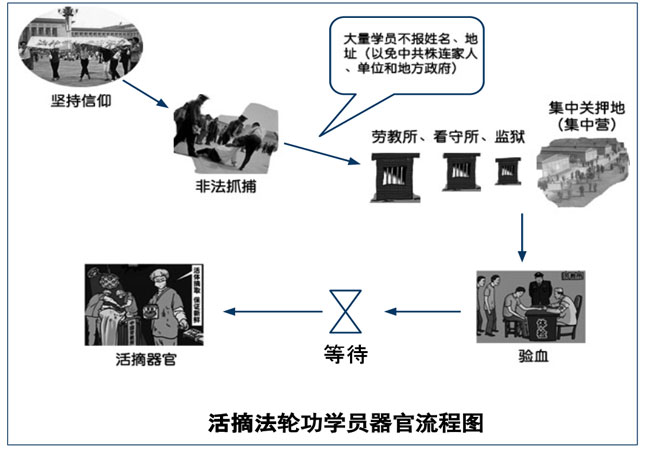
Figure 3. The steps of the CCP’s illegal organ trade targeting Falun Gong practitioners
“The process of organ harvesting from Falun Gong practitioners is operated primarily by the military. The Central Military Commission gave the military the authority to oversee the process and designated specific military personnel and institutions to carry out the different steps of organ harvesting. Information related to this is classified military information. Military personnel overseeing the process are authorized to arrest, detain, and execute any doctors, police, armed police and researchers that leak information. Many military facilities are actual concentration camps.”
The elderly military surgeon, who had personally processed thousands of forged voluntary organ donation files said that “For anyone designated to be live organ harvested, many of these people would be taken away from their prisons, labor camps, detention centers, concentration camps and other places. Then they would lose their names and only be identified by code numbers. Corresponding to one code number, there is a forged ‘voluntary organ donor’. And this person would be told to undergo a physical examination. The person would then receive local anesthesia; the next step would be living donor organ transplantation. Victims of organ harvesting are no longer treated as human beings but animals. When you perform one or two cases of organ harvesting, [doctors and others involved] may still have fear in their hearts. But after having performed tens of thousands of such operations, they have grown very numb to extracting organs and cremating bodies that are still alive.”
“Officially, all organ donors are voluntary. During imprisonment, Falun Gong practitioners and others used their real names. But when a prisoner is chosen for organ harvesting, a false name is given to the person. Basically, a fake person is then created with complete records and a voluntary signature on organ donation consent papers. Of course, the signature is signed by someone else. I have personally processed more than 60,000 forged consent papers.”
IX. FATAL FLAWS IN THE OFFICIAL EXPLANATION
For over a decade, the Chinese medical establishment has attempted to explain away the explosive growth of mainland china’s organ transplant industry after 1999 as simply the result of a growing number of voluntary organ donors, a vast pool of executed prisoner donors, individual private organ transactions, or various combinations thereof. Yet these explanations collapse under even the lightest of scrutiny.
The pilot project for mainland china’s human organ donation system did not start until march 2010, and the post mortem organ donation rate is only 0.6ppm (0.6 per 1 million people)[179] [180]:
In March 2010, the Chinese human organ donation system’s pilot project started in Shanghai, Tianjin, Liaoning Province, Shandong Province, Zhejiang Province, Guangdong Province, Jiangxi Province, Xiamen of Fujian Province, Nanjing of Jiangsu Province, and Wuhan of Hubei Province. On April 20, 2010, Guangdong Province’s Human Organ Donation Pilot Project officially went into operation.
According to Huang Jiefu, China has about 300,000 patients annually who are in urgent need for organ transplants, yet there were only about 10,000 transplant operations per year. With a post mortem organ donation rate of 0.6ppm, China is among the countries with the lowest organ donation rates in the world.[181] Professor Chen Zhonghua of the Tongji University School of Medicine, which is affiliated with the Huangzhong University of Science and Technology, stated that from 2003 to August 2009, there were only 130 cases of successful organ donation from deceased mainland Chinese citizens. Also according to the data released on the 2014 Chinese Organ Transplant Conference, in the three-year period from 2010 to 2013, there were only 1,448 cases of organ donation from deceased mainland Chinese citizens.[182]
Death row prisoner organ donors can provide only a minority portion of organs:
According to Amnesty International’s records, from 1995 to 1999, the annual average of executed death row prisoners in China was around 1,680 per year. Between 2000 and 2005, the average number was 1,616 per year. These numbers would vary from year to year, but overall, the average numbers before and after the persecution of Falun Dafa practitioners started were about the same[183]. While the Amnesty International numbers have never been considered definitive - and indeed, may be a lowball estimate - refugees from the Mainland anecdotally support the premise that the official execution rate has appeared to lessen in recent years, suggesting, at a minimum, that the velocity of using hard-core criminals as an organ source is not increasing but decreasing.
Yet the larger problem of using death-row prisoners and hardened criminals for their organs is structural and long-term; due to a myriad of health issues, only a small number of China’s death row inmates can actually be used as healthy organ donors. As per the criteria for organ transplants, people with the following medical conditions cannot become donors: fatty liver, hepatitis B, hepatitis A, hepatitis C, cancer, infections, diabetes, a history of cardiovascular diseases, HIV antibodies, syphilis antibodies, hypertension, heart illnesses, tuberculosis and a history of kidney and liver diseases. David Matas estimates that these factors combined create a situation where it would require ten death-row prisoners for one organ recipient. According to the official data, the proportion of Chinese people, who have developed one or more of the above medical conditions, is very high:
· In China, about 9% of the population carry the hepatitis B virus, a total of 120 million people[184]; the hepatitis C virus infection rate is 0.43%[185]; A focus on Chinese cities found the infection rate of Hepatitis B markers to be above 60%.
· Among the people aged 15 years and above, 24% have hypertension, with a total of 266 million people.[186]
· China’s diabetes prevalence rate is the highest in the world, with 11.6% of Chinese adults suffering from this disease. Whereas in the United States, this rate is 11.3%.[187]
· “According to several urban population sampling surveys, the Chinese adults’ fatty liver prevalence rate is 12.5% and 35.4%. Fatty liver has replaced viral hepatitis to become the most prevalent liver disease in China’s population.” Professor Zeng Minde, the honorary leader of the Fatty Liver and Alcoholic Liver Disease Study Group at Chinese Liver Disease Association of the Chinese Medical Association, said that since in China the prevalence rates of obesity and type 2 diabetes had showed a significant growth trend, it is expected that in the near future, the prevalence of fatty liver will rise.[188]
In the December 2008 issue of The Lancet, Huang Jiefu published an article entitled “The Chinese Government’s Organ Transplant Policy.” The article stated, “In China, more than 90% of transplanted organs are obtained from executed prisoners.[189]” However that percentage has been systematically rejected by independent experts. For example, in 2009, Minghui.org published an analysis concluding that even with the largest number of death row inmates (10,000 per year) and the largest proportion of death row inmates providing organs, between 2003 and 2006, the CCP still had obtained 45,000 organs from unknown sources (a similar finding to the Kilgour/Matas estimate of 41,500 over the period 2000 to 2005, and Ethan Gutmann’s survey-based estimate of 65,000 between 2000 - 2008).[190]
The organs obtained from private sellers were very few and insignificant even based on the reports by CCP’s official media outlets:
The state-controlled press has produced a few high-profile reports on individuals selling their own organs. However, the quantity was so miniscule that they could not even be expressed as a percentage of the 10,000 organ transplant donors. Clearly the reports were essentially meant to be anecdotal rather than numerical. As there were no follow-ups by the officials, the reportage appears to have been an attempt to create a brief obfuscation or a throwaway explanation for Western reporters.
X. CHAPTER CONCLUSIONS
- The trajectory of the medical “gold rush” in harvesting corresponds with the trajectory of Falun Gong incarceration.
- The organ harvesting of Falun Gong, particularly the exploitation of “nameless” practitioners, filled any potential gap in organ supply.
- Organ harvesting of living human beings became the default procedure throughout China.
- Official attempts to present alternate organ sourcing scenarios for the “gold rush” collapses under scrutiny.
In the remaining chapters we will present detailed evidence on the complicity of the Chinese State, the full scale of the CCP’s organ harvesting from living Falun Gong practitioners and, most important, why we believe the practice is ongoing.
References:
[1] (2004, Aug. 25). The Journey of Falun Dafa: A Bright but Arduous Path. Minghui.
Retrieved from: http://www.clearwisdom.net/emh/articles/2004/9/26/52823.html
[2] (2004, Aug. 25). The Journey of Falun Dafa: A Bright but Arduous Path. Minghui.
Retrieved from: http://www.clearwisdom.net/emh/articles/2004/9/26/52823.html
[3] (2006, May. 20). Eternal Praise from All Beings. Minghui.
Retrieved from: http://www.clearwisdom.net/emh/articles/2006/5/20/73526.html
[4] (2006, May. 9). Brutal Tragedy is Still Ongoing. Minghui.
Retrieved from: http://www.minghui.org/mh/articles/2006/5/9/127277p.html
[5] (2006, Mar. 12). Holland Media Exposes Atrocities of Sujiatun Concentration Camp in Shenyang. Minghui.
Retrieved from: http://www.clearwisdom.net/emh/articles/2006/3/12/70740.html
[6] (2013, Sept. 11). Collection of Evidence of Live Organ Harvesting from Falun Gong Practitioners by the Chinese Communist Party. WOIPFG.
English: http://www.upholdjustice.org/node/241
[7] (2013, Nov. 16). The Largest Number of Inmates in Forced Labor Camps Reached 300,000. Caijing (Financial Network).
Retrieved from: http://politics.caijing.com.cn/2013-11-16/113573773.html
WOIPFG’s archived link: /sites/default/files/201709/report/2015/325-7.png
[8] China (includes Hong Kong, Macau, and Tibet): Abuses of Religious Freedom Some foreign observers estimated that at least half of the 250,000 officially recorded inmates in the country's reeducation-through-labor camps were Falun Gong adherents. Falun Gong sources overseas placed the number even higher. 2006 Report on International Religious Freedom. US Department of State (Bureau of Democracy, Human Rights, and Labor).
Retrieved from: http://www.state.gov/g/drl/rls/irf/2006/71338.htm
[9] (2006, May. 20). On the Chinese Communist Party's Murder Industry in Recent Years, Part 1. Minghui.
Retrieved from: http://www.clearwisdom.net/emh/articles/2006/5/20/73525.html
[10] (2010, Mar. 26). The Maze of Organ Donation. Netease (retrieved from), Southern Weekend (Guangzhou)(source).
WOIPFG archive link: http://www.upholdjustice.org/upload/images/nationalcriminalreports/10.jpg
[11] (2005, Jan. 1 – 2006, Jun. 22). Number of Cases of Liver Transplantation Registered in Chinese Mainland is 5680 (HKT 11:05:34). China Liver Transplant Registry Network Statistics.
Retrieved from: http://cltr.org/
WOIPFG’s archived link:
http://www.zhuichaguoji.org/sites/default/files/report/2015/59389_11.png
[12](2005, Jan. 1 – 2007, Jun. 24). Number of cases of liver transplantation registered in Chinese Mainland (HKT 12:34:39). China Liver Transplant Registry Network" Statistics.
Retrieved from: http://cltr.org/
WOIPFG’s archived link:
http://www.zhuichaguoji.org/sites/default/files/report/2015/59389_12.png
[13] Zheng Shusen, Liang Tingbo, Xu Xiao, Wang Weilin, Shen Yan, Zhang Min, Huang Dongsheng. (310003, Hangzhou, First Affiliated Hospital, Zhejiang University School of hepatobiliary and pancreatic surgery and organ transplant centers). (2003, Feb). Review of 120 Cases of Liver Transplant in 10 Years’ Experience. Chinese Journal of General Surgery, 2003, Vol.18, No. 02, pp.71-73.
WOIPFG’s archived link:
http://www.upholdjustice.org/upload/images/nationalcriminalreports/1301.pdf
http://www.upholdjustice.org/upload/images/nationalcriminalreports/1302.pdf
http://www.upholdjustice.org/upload/images/nationalcriminalreports/1303.pdf
[14](2014, July. 8). Zhejiang University Hospital Has Conducted 1521 Cases of Liver Transplantation. Chinese Organ Transplant Network.
Retrieved from:
http://www.transplantation.org.cn/ZheJiangDaXueFuShuDiYiYiYuanKuaiXun/2014-07/7145.htm
WOIPFG’s archived link:
http://www.upholdjustice.org/upload/images/nationalcriminalreports/14.png
[15] Huang Hongfeng, Chen Jianghua, Wang Yimin, Wu Jianyong, Zhang Jianguo, Shou Zhangfei. (First Affiliated Hospital, Zhejiang University School of kidney transplantation blood purification center, Hangzhou, 310 003). (2000, Jun). Kidney Transplant Patients with Malignant Tumors (Clinical Analysis of 5 Cases). Chinese Journal of Nephrology, Dialysis & Transplantation, 2000, Vol.9, No. 03, pp226-228.
WOIPFG’s archived link:
http://www.upholdjustice.org/upload/images/nationalcriminalreports/15.pdf
[16](2012, May. 18). Professor Chen Jianghua Awarded the "International Medal for Outstanding Achievement" by the U.S. National Kidney Foundation (Terminal Stage Renal Disease Treatment at the Zhejiang University First Affiliated Hospital ‘s Nephrology Center Receives International Recognition). Zhejiang Online Health Network.
Retrieved from: http://health.zjol.com.cn/system/2012/05/18/018500632.shtml
WOIPFG’s archived link:
http://www.upholdjustice.org/upload/images/nationalcriminalreports/16.png
[17]Organ Transplant Tourism. Baidu Baike.
Retrieved from:
http://www.baike.com/wiki/%E5%99%A8%E5%AE%98%E7%A7%BB%E6%A4%8D%E6%97%85%E6%B8%B8
WOIPFG’s archived link:
http://www.upholdjustice.org/upload/images/nationalcriminalreports/17.png
[18](2006, Jan. 5). The 2005 Year-end Conference. Oriental Organ Transplant Center.
Retrieved from: http://www.ootc.net/HomePage/FileDocDetail.aspx?fileno=494
WOIPFG’s archived link :
http://www.upholdjustice.org/upload/images/nationalcriminalreports/18.png
[19]Fan Yu , Bao Erdun , Liu Zhihong , Zhang Xianyou, Tan Jianming (200080, Shanghai First People's Hospital of Urology ). (2003, Mar). 47 Cases of Malignant Renal Transplantation Analysis. Chinese Journal of Organ Transplantation, Vol.24, No. 02, pp.115-116.
WOIPFG’s archived link :
http://www.upholdjustice.org/upload/images/nationalcriminalreports/1901.pdf
http://www.upholdjustice.org/upload/images/nationalcriminalreports/1902.pdf
[20]Overview of Shanghai First People's Hospital. Medical Network.
Retrieved from: http://jiuyi.ewsos.com/yiyuan/jianjie-ShangHaiDiYiRenMinYiYuan430089
WOIPFG’s archived link:
http://www.upholdjustice.org/upload/images/nationalcriminalreports/20.png
[21]Tan Yizhen, Li Liuyang, Wang Rui’ai, Wen Jun (First Military Medical University Affiliated Zhujiang Hospital, renal blood purification transportation Branch, Guangdong, Guangzhou, 510282, China). (2000, Sept). Analysis of the Factors Influencing the Quality of Tissue-typing in Renal Transplantation Recipients. Journal of Practical Nursing, Vol.16, No. 09, pp.21-22.
WOIPFG’s archived link:
http://www.upholdjustice.org/upload/images/nationalcriminalreports/2101.pdf
http://www.upholdjustice.org/upload/images/nationalcriminalreports/2102.pdf
[22]Ming Aiming, Lin minzhuan, Zhao Ming, Yue Liangsheng, Guo Ying, Xu Yongkang. (2002, May). The Complication of Pneumocystis Carinii Pneumonia After Renal Transplantation-Four Case Studies. Journal of Organ Transplantation, Vol.23, No. 03, pp.178.
WOIPFG’s archived link:
http://www.upholdjustice.org/upload/images/nationalcriminalreports/22.pdf
[23]Fan Lipei, Zhao Ming, Huang Xian’en (Zhujiang Hospital, First Military Medical University, Department of Organ Transplantation, Guangzhou, 510282, China). (2003, Jan). Cause and Treatment of Fistula After Renal Transplantation. Guangdong Medicine Journal, Vol.24, No. 01, pp.110.
WOIPFG’s archived link:
http://www.upholdjustice.org/upload/images/nationalcriminalreports/23.pdf
[24]Lin Rongxi, Ou Liangming, Chen Zixuan, Hong Jiaping, Lin Wenhong, Wu Weizhen, Yang Shunliang, Xu Tingzhao, Cai Jinquan, Zhang Ming (Fuzhou General Hospital of Nanjing Military Region, Department of Urology, Fuzhou, 350001). (1999, July). Analysis on 69 cases of Specific Infections After Renal Transplantation. Chinese Journal of Organ Transplantation, Vol.20, No. 03, pp.144-145.
WOIPFG’s archived link:
http://www.upholdjustice.org/upload/images/nationalcriminalreports/24.pdf
[25]Wang Dong, Tan Jianming, Wu Weizhen, Yang Shunliang, Lin Wenhong, Xu Tingzhao, Cai Jinquan, Tao Xiaoqin, Yang Xiaoling (Fuzhou General Hospital of Nanjing Military Region, Department of Urology, Fuzhou, 350025, China). (2007). Clinical Experience on Treating Severe Pneumonia After Renal Transplantation. Journal of the Fourth Military Medical University, Vol.28, No. 04, pp.346-349.
WOIPFG’s archived link:
http://www.upholdjustice.org/upload/images/nationalcriminalreports/2501.pdf
http://www.upholdjustice.org/upload/images/nationalcriminalreports/2502.pdf
http://www.upholdjustice.org/upload/images/nationalcriminalreports/2503.pdf
http://www.upholdjustice.org/upload/images/nationalcriminalreports/2504.pdf
[26]Zhang Genfu, Huang Chibing, Wang Pingxian, FAN Mingqi, Feng Jiayu, Xiao Ya, Fang Zhenqiang, Jia Weisheng (Xinqiao Hospital, Third Military Medical University, Department of Urology, Chongqing, 400037). (2007, Dec). Clinical Analysis on 3102 Cases of Cadaveric Renal Transplantation. Chongqing Medicine, Vol.36, No. 24, pp.2535-2537.
WOIPFG’s archived link:
http://www.upholdjustice.org/upload/images/nationalcriminalreports/26.pdf
[27]Wang Pingxian , Zhang Yinfu , Huang Chibing , Fan Mingqi , Feng Jiayu , Xiao Ya , Fang Zhenqiang ( Xinqiao Hospital, Third Military Medical University, Department of Urology , Chongqing , 400037). (2008, July). Clinical Research of the Role of Alprostadil in Promoting Early Recovery of Renal Transplantation. Chongqing Medicine, Vol. 37, No. 14, pp1528-1530.
WOIPFG’s archived link :
http://www.upholdjustice.org/upload/images/nationalcriminalreports/27.pdf
[28]Ao Jianhua, Lu Jinshan Xiao Xuren , Dong Jun, Li Yantang ( People's Liberation Army General Hospital, Department of Urology , Beijing , 100853 ). (2010, May). Analysis of Clinical Data on Recipients Survived for More Than 10 Years After Renal Transplantation. Chinese Journal of Organ Transplantation, Vol.31, No. 05, pp.273-275.
WOIPFG’s archived link :
http://www.upholdjustice.org/upload/images/nationalcriminalreports/28.pdf
[29]Xiao Xuren , Ao Jianhua , Lu Jinshan , Hong Baofa , Ye Linyang , Zhang Lei , Cai Wei , Gao Jiangping, He Xueyou, Yang Yong , Dong Jun , Wang Xiaoxiong , Li Yantang , Xu Dianyi (Liberation Army General Hospital, Department of Urology , Beijing , 100853 ). (2007). Retrospective Analysis on 2037 cases of Renal Transplantation. Chinese Transplant (Electronic Version), Vol 1, No. 01, pp.4-8.
WOIPFG’s archived link
http://www.upholdjustice.org/upload/images/nationalcriminalreports/29.pdf
[30]Yu Lixin , Xu Jian , Ye Guirong , Fu Shaojie , Ma Junjie , Deng Wenfeng , Du Chuanfu , Wang Yibin , Yao Bing (510515, China , Guangzhou Nanfang Hospital, First Military Medical University Renal Transplantation ). (2002, Apr). Clinical Summary of 2123 Cases of Kidney Transplant. Chinese Journal of Surgery, Vol. 40, No. 04, pp.248-250.
WOIPFG’s archived link :
http://www.upholdjustice.org/upload/images/nationalcriminalreports/30.pdf
[31](2009, July. 16). Introduction of the Department of Kidney Transplantation. Nanfang Hospital official website.
Retrieved from: http://news.nfyy.com/nfsyzkMe/579.htm
WOIPFG’s archived link:
http://www.upholdjustice.org/upload/images/nationalcriminalreports/31.pdf
[32]Zheng Junhua, Min Zhilian, Zhu Youhua, Li Yuli, Qi Jun, Ren Jizhong, Wang Liming, Wang Yawei, Xu Danfeng, Zhou Meisheng, Dong Zhen (200003, Shanghai, Changzheng Hospital, Second Military Medical University, PLA Urology Center, kidney transplant center). (1999). A Discussion on the Pathological Mechanism and Clinical Treatments of Super Acute Rejection in Kidney Transplant. Shanghai Medical Journal, Vol. 22, No. 09, pp.522-525.
WOIPFG’s archived link:
http://www.upholdjustice.org/upload/images/nationalcriminalreports/32.pdf
[33]Zhou Meisheng, Zhu Youhua, Min Zhilian, Zheng Junhua, Wang Yawei (200,003, Shanghai Changzheng Hospital, Second Military Medical University Organ Transplant Center). (2004, Nov). Studies of Male Hormones, Trace Elements and Erectile Function on Kidney Transplant Patients Before and After Kidney Transplant. Chinese Journal of Organ Transplantation, Vol. 25, Phase 06, pp.328-330.
WOIPFG’s archived link:
http://www.upholdjustice.org/upload/images/nationalcriminalreports/33.pdf
[34]Introduction of the Ministry of Health Forensic Pathology Key Laboratory. Xi'an Jiaotong University.
Retrieved from:
http://www.xjtu.edu.cn/xynr.jsp?urltype=tree.TreeTempUrl&wbtreeid=1634&wbxjtucollegeid=250
WOIPFG’s archived link:
http://www.upholdjustice.org/upload/images/nationalcriminalreports/34.pdf
[35](2010, Nov. 17). Introduction of the Organ Transplant Center. The 309th Hospital of Chinese People’s Liberation Army.
Retrieved from: http://www.309yy.com/_Dept/View.aspx?id=3323 (page no longer valid)
WOIPFG’s archived link:
http://www.upholdjustice.org/upload/images/nationalcriminalreports/35.png
[36]Our Hospital Liver Transplant Department has An Excellent Team of Physicians. PLA Second Artillery General Hospital.
Retrieved from: http://www.epzyy.com/News/Articles/Index/1348 (page no longer valid)
WOIPFG’s archived link:
http://www.upholdjustice.org/upload/images/nationalcriminalreports/36.png
[37](2009, Feb. 25). Introduction of the Liver Transplant Center of the General Hospital of Beijing Military Region.
Retrieved from: http://jzgdk.cnkme.com/papers/show/21865
WOIPFG’s archived link:
http://www.upholdjustice.org/upload/images/nationalcriminalreports/37.png
[38]Liu Zhenwen. Liver Disease Rehabilitation Garden.
Retrieved from: http://www.jk300.com/liuzhengwen.htm
WOIPFG’s archived link:
http://www.upholdjustice.org/upload/images/nationalcriminalreports/38.png
[39]Introduction of the 307th Hospital of Chinese People’s Liberation Army. Baidu Encyclopedia.
Retrieved from: http://www.baike.com/wiki/307%E5%8C%BB%E9%99%A2
WOIPFG’s archived link:
http://www.upholdjustice.org/upload/images/nationalcriminalreports/39.png
[40]Features of the Institute of Liver Transplant. Armed Police General Hospital.
Retrieved from: http://www.wj-hospital.com/yjshzx1/yz/
WOIPFG’s archived link:
http://www.upholdjustice.org/upload/images/nationalcriminalreports/40.pdf
[41]Introduction of the Department of Hepatobiliary at the Affiliated Beijing You’An Hospital, Capital Medical University. Good Doctor Online.
Retrieved from: http://www.haodf.com/faculty/DE4roiYGYZwIQrvS30yF9V0wc/jieshao.htm
WOIPFG’s archived link:
http://www.upholdjustice.org/upload/images/nationalcriminalreports/41.pdf
[42](2013, Dec. 3). [Hospital News] Peking University People's Hospital Hosted the Second Human Organ Procurement Organization Training and Human Organ Transplantation Policy Training. Peking University People’s Hospital, Information Week Vol. 21.
Retrieved from: http://dxb.bjmu.edu.cn/art/2013/12/3/art_12568_91407.html
WOIPFG’s archived link:
http://www.upholdjustice.org/upload/images/nationalcriminalreports/42.pdf.
[43]Chronicle of Events at the Organ Transplant Center of the Third Hospital of Peking University. The Third Hospital of Peking University Liver Transplantation Center.
Retrieved from: http://www.liver-tx.net/jj05.html
WOIPFG’s archived link:
http://www.upholdjustice.org/upload/images/nationalcriminalreports/43.png
[44]Introduction of Beijing Haidian Hospital. Integrated Information Network.
Retrieved from: http://www.zizhong.com.cn/AG/2005/1257.html
WOIPFG’s archived link:
http://www.upholdjustice.org/upload/images/nationalcriminalreports/44.png
[45]Introduction of Affiliated Zhongshan Hospital. Shanghai to help doctors Network.
Retrieved from: http://www.91985.com/jibing/xiaochuan/yiyuan.asp?id=116
WOIPFG’s archived link:
http://www.upholdjustice.org/upload/images/nationalcriminalreports/45.png
[46]Chen Qing (reporter), Qin Sicui (Correspondent). (2003, Dec. 9). Zhongshan Hospital Cooperates with the World's Largest Organ Transplant Agencies to Step up Organ Transplantation. Sina.
Retrieved from: http://news.sina.com.cn/c/2003-12-09/08301293869s.shtml
WOIPFG’s archived link:
http://www.upholdjustice.org/upload/images/nationalcriminalreports/46.png
[47]Introduction of Shanghai Clinical Center for Organ Transplantation (subsidiary of Shanghai First People's Hospital). Shanghai Jiaotong University School of Medicine website.
Retrieved from: http://www.shsmu.edu.cn/default.php?mod=article&do=detail&tid=869374
WOIPFG’s archived link:
http://www.upholdjustice.org/upload/images/nationalcriminalreports/47.pdf
[48](2005, Jan. 20). The Surgery Department of Shanghai Jiaotong University Affiliated Ruijin Hospital (key disciplines)
Retrieved from: http://www.rjh.com.cn/2013ruijin/ruijin/ylts/lcks/6486.shtml
WOIPFG’s archived link:
http://www.upholdjustice.org/upload/images/nationalcriminalreports/48.png
[49]Introduction of Lung Transplant Division. Shanghai Thoracic Hospital website.
Retrieved from: http://chest.shxkyy.com/hospital/ksjs.aspx?id=27
WOIPFG’s archived link:
http://www.upholdjustice.org/upload/images/nationalcriminalreports/49.png
[50]Introduction of Tianjin First Central Hospital. Hospital Website.
Retrieved from: http://www.tj-fch.com/sitecn/yyjj/1587.html
WOIPFG’s archived link:
http://www.upholdjustice.org/upload/images/nationalcriminalreports/426.png
[51]Introduction of Southwest Hospital Institute of Hepatobiliary Surgery. Hepatobiliary Sky.
Retrieved from: http://www.hbsky.org/gyz/gyzyemian.html
WOIPFG’s archived link:
http://www.upholdjustice.org/upload/images/nationalcriminalreports/51.png
[52] (2006). The History of Organ Transplant at Our Hospital. Journal of the First Affiliated Hospital of Wenzhou University, 2006, Vol. 18 & 19.
Retrieved from:
http://www.hosp1.ac.cn/wyyyweb/wlybview.aspx?id=3949 (page no longer valid)
WOIPFG archived link: http://www.zhuichaguoji.org/cn/images/nationalcriminalreports/52.png
[53] Overview of the Transplant Center at the First Affiliated Hospital of Wenzhou University.
Retrieved from: http://www.hosp1.ac.cn/wyyy/web/ksts/lcks.aspx?ksmc=%D2%C6%D6%B2%BF%C6
WOIPFG archived link: http://www.zhuichaguoji.org/cn/images/nationalcriminalreports/53.pdf
[54] Introduction of the Transplantation division. Third Xiangya Hospital, Central South University website.
Retrieved from: http://www.xy3yy-shfw.com/dwk/yzzk/
WOIPFG’s archived link:
[55]Multi-organ Combined Transplantation Research Key Laboratory of the Ministry of Health. Baidu Encyclopedia.
Retrieved from: http://baike.baidu.com/view/3125503.htm
WOIPFG’s archived link:
http://www.upholdjustice.org/upload/images/nationalcriminalreports/55.pdf
[56]Introduction of the Organ Transplantation division. Shanghai Changzheng Hospital website.
Retrieved from: http://www.shczyy.com/App/Office/OfficeDetail.aspx?OfficeID=21 (page no longer valid)
WOIPFG’s archived link:
http://www.upholdjustice.org/upload/images/nationalcriminalreports/56.png
[57]The Matching Process - Waiting List. US Department of Health.
Retrieved from:https://web.archive.org/web/20080319121753/http://www.organdonor.gov/transplantation/matching_process.htm
WOIPFG’s archived link:
http://www.upholdjustice.org/upload/images/nationalcriminalreports/57.png
[58]Chen Yanhui (reporter). (2006, Feb. 22). Investigation of Global Organ Transplant – Investigation of Tens of Thousands Foreigners Visiting China for Organ Transplants, China becoming the World's Emerging Organ Transplant Center. Phoenix.
Retrieved from: https://web.archive.org/web/20100611090330/http://news.ifeng.com/phoenixtv/83932384042418176/20060222/751049.shtml
WOIPFG’s archived link:
http://www.upholdjustice.org/upload/images/nationalcriminalreports/58.png
[59] (2014, Oct. 13). Evidence of Live Organ Harvesting of Falun Gong Practitioners Collected from Chinese Medical Papers. WOIPFG.
Retrieved from: http://www.upholdjustice.org/node/263
[60]Yuan Xiaopeng, Jiao Weihua, Li Jie, Guo Zaizhu, Gao Wei. (2006). A Modified Technique for Combined Liver and Kidney Procurement and its Clinical Application. Hainan Medical Journal. [J]. 2006, 17(02) pp.19-20
WOIPFG archived link:
http://www.upholdjustice.org/upload/images/medicalarticles/6701.pdf
http://www.upholdjustice.org/upload/images/medicalarticles/6702.pdf
[61]Li Shiyong, Bai Xue, Chen Gang, Liang Zhenjia, Yuan Shujun, Yu Bo, Chen Guang, Zuo Fuyi, Wei Xiaojun, Xu Yishi, Wei Cui. (2008). Observation of 30 Cases of Orthotopic Liver Transplantation. Medical Journal of National Defending Forces in north China. [J]. 2008,20(02), pp.14-15
WOIPFG archived link:
http://www.upholdjustice.org/upload/images/medicalarticles/6801.pdf
http://www.upholdjustice.org/upload/images/medicalarticles/6802.pdf
[62]Xie Shuiben, Zhang, Zaigao, Bei Yajun, Xue Zhiqiang, Jiang Xiangwei, Zhao Zhe, Li Han. (2006). The Orthotopic Heart Transplantation with Long Donor Heart preservation in 3 Patients. Journal of Cardiovascular of and Pulmonary Diseases. [J]. 2006,25(04), pp.241,243
WOIPFG archived link:
http://www.upholdjustice.org/upload/images/medicalarticles/6901.pdf
http://www.upholdjustice.org/upload/images/medicalarticles/6902.pdf
[63]Han Jie, Meng Xu, Zhang Haibo, Zeng Wen, Xu Chunlei, Li Fei, Sun Linbo. (2006). Experiences of Orthotopic Heart Transplantation: A report of 51 cases. Chinese Journal of Thoracic and Cardiovascular Surgery. [J]. 2006,22(06), pp.390-391.
WOIPFG archived link: http://www.upholdjustice.org/upload/images/medicalarticles/70.pdf
[64]Zang Yunjin, Li Zhiqiang, Guo Yuan, Li Ziqiang, Tian Gendong, Sun Kai, Yu Zhenhai, Shen Zhongyang. (2005). The Orthotopic Liver Transplantation for Treating End-stage Liver Disease: Experiences in 43 Cases. Chinese Journal of Current Advance in General Surgery. [J]. 2005,8(06), pp. 365-366, 369
WOIPFG archived link:
http://www.upholdjustice.org/upload/images/medicalarticles/7101.pdf
http://www.upholdjustice.org/upload/images/medicalarticles/7102.pdf
http://www.upholdjustice.org/upload/images/medicalarticles/7103.pdf
[65]Liu Tianqi, Wang Dong, Li Peijie, Li Min, Ma Yanping, Wang Minghua, Li Jun, Xu Li, Li Quan, Zhang Hui, Lu Ping. (2013). Analysis on 25 Cases of Orthotopic Cardiac Transplantation for End-stage Heart Disease. Chinese Journal of Transplantation (Electronic version). [J]. 2013,7(01), pp.10-13
WOIPFG archived link: http://www.upholdjustice.org/upload/images/medicalarticles/72.pdf
[66]Yu Guangshen, Liu Jun, Xu Shifeng, Yang Fenghui, Zhou Xu, Gong Wei, Xu Yantian, Lu Jun. (2009). Combined liver-kidney Transplantation: a Report of 6 Cases. Chinese Journal of General Surgery.[J]. 2009,24(10), pp. 851-852.
WOIPFG archived link:
http://www.upholdjustice.org/upload/images/medicalarticles/7301.pdf
http://www.upholdjustice.org/upload/images/medicalarticles/7302.pdf
[67]Li Sen, Li Chunyou, Du Futian, Zhuang Guanyi, Ding Wei, Song Qinhua. (2006). The Clinical Application of Orthotopic Liver Transplantation (with 9 Cases). ACTA Academiae Medicinae Weifang. [J]. 2006,28(06), pp.410-413.
WOIPFG archived link: http://www.upholdjustice.org/upload/images/medicalarticles/74.pdf
[68]Zhang Qingguang, Chen Jingyu, Gao Xuejun, Zhang Lianguo, Wang Xiaozhi, Wang Yujiu, Yang Xinfang, Wang Jianbo, Qi Mei, Wang Hongli. (2006). Single Lung Transplantation and Ventricular Septal Defect Repair for Eisenmenger Syndrome: Report of One Case. Chinese Journal of Organ Transplantation. [J]. 2006,27(02), pp.81-83
WOIPFG archived link:
http://www.upholdjustice.org/upload/images/medicalarticles/7501.pdf
http://www.upholdjustice.org/upload/images/medicalarticles/7502.pdf
http://www.upholdjustice.org/upload/images/medicalarticles/7503.pdf
[69]Chen Liangwan, Chen Daozhong, Dai Binguang, Qu Qi, Guo Shangyun, Qiu Hanfan, Wu Xijie, Wang Zengchun. (2008). Heart Transplantation with Donor Hearts of Brain Death Patients for 2 Cases. Chinese Journal Of Cardiovascular Review. [J]. 2008,6(02), pp.90-92.
WOIPFG archived link:
http://www.upholdjustice.org/upload/images/medicalarticles/7601.pdf
http://www.upholdjustice.org/upload/images/medicalarticles/7602.pdf
http://www.upholdjustice.org/upload/images/medicalarticles/7603.pdf
[70]Liu Qilong, Jiang Biao, Wang Ai'liang, Liu Zhiqiang, Zhang Xin, Jia Zhenzhong, Liu Guohe, Li Yongqiang, Jiang Bo. (2003). Immunosuppressive Regimen for Orthotopic Liver Transplantation (with a case). Journal of Jining Medical college. [J]. 2003,26(04), pp.20-21.
WOIPFG archived link:
http://www.upholdjustice.org/upload/images/medicalarticles/7701.pdf
http://www.upholdjustice.org/upload/images/medicalarticles/7702.pdf
[71]Xu Liyou, Liu Zhao, Song Zhao, Yang Lin, Zhan Zhiyong, Song Guodong, Jiang Yong, Guo Nongjian, Jia Tanghong. (2003). The Value of Liver Transplantation In Hepatocarcinoma: Report of a Case with Huge Liver Cancer. China Journal of cancer prevention and treatment. [J]. 2003,10 (11), pp.1231-1232.
WOIPFG archived link:
http://www.upholdjustice.org/upload/images/medicalarticles/7801.pdf
http://www.upholdjustice.org/upload/images/medicalarticles/7802.pdf
[72]Yang Shouguo, Wang Chunsheng, Chen Hao, Hong Tao, Hu Kejian, Zhuang Yamin, Lin Yi, Yang Zhaohua. (2011). Long-term Results of 298 Cases of Orthotopic Heart Transplantations. Chinese Journal of transplantation (Electronic version) . [J]. 2011, 05 (02), pp.101-105.
WOIPFG archived link: http://www.upholdjustice.org/upload/images/medicalarticles/79.pdf
[73]Lu Lizhi, Hu Huaizhang, Jiang Yi, Yang Fang, Zhang Shaogeng, Lin Hua. (2004). Donor Liver Procurement in Liver Transplantation. Anatomy and Clinic. [J]. 2004,9 (04), pp.247-248,250.
WOIPFG archived link: http://www.upholdjustice.org/upload/images/medicalarticles/80.pdf
[74]Kang Kai, Xie Baodong, Han Zhen, Deng Suoqin, Wang Dong, Chuo Junbo, Jiang Shulin. (2007). A Report and Analysis of an Orthotopic Heart Transplantation on a Patient with End-stage Coronary Heart Disease. Chinese Journal of Clinical Thoracic and Cardiovascular Surgery. [J]. 2007, 14(01), pp.57-59.
WOIPFG archived link: http://www.upholdjustice.org/upload/images/medicalarticles/81.pdf
[75]Wang Zhenxing, Chen Jingyu, Zheng Mingfeng, Ye Shugao, Liu Feng, Chen Ruo, Lu Rongguo, WeiDong. (2012). 100 Cases of Lung Harvesting for Lung Transplantation: Effect of Cold Ischemia Time > 6 Hours and Lung Volume Reduction on Prognosis. Journal of Clinical Rehabilitative Tissue Engineering Research. [J]. 2012, 16 (05), pp.835-838.
WOIPFG archived link: http://www.upholdjustice.org/upload/images/medicalarticles/82.pdf
[76]Zhang Chuanyong, Qian Xiaofeng, Wang Ping, Wang Ke, Wang Xuehao. (2006). Diagnosis and Treatment of Biliary Complications after Orthotopic Liver Transplantation. Acta Universitatis Medicinalis Nanjing (Natural Science). [J]. 2006, 26(11), pp1056-1057,1060.
WOIPFG archived link: http://www.upholdjustice.org/upload/images/medicalarticles/83.pdf
[77]Qian Haixin, Zhou Xiaojun, Tian Liping, Liu Jianxia, Mao Zhongqi, Hu Hao, Qin Lei, Chen Yiren. (2002). Perioperative Management of Orthotopic Liver Transplantation. Jiangsu Medical Journal. [J]. 2002, 28(01), pp.1-3.
WOIPFG archived link: http://www.upholdjustice.org/upload/images/medicalarticles/84.pdf
[78]Yu Yunsheng, Shen Zhenya, Yu Shudong, Zhu Jiang, Ye Wenxue, Jiao Peng, Huang Haoyue, Zhu Yaping, Bu Lifen, Hu Yanqiu. (2007). Perioperative Management of Orthotopic Cardiac Transplantation (with 6 Cases). Suzhou University Journal of Medical Science. [J]. 2007, 27(04), pp. 643-645.
WOIPFG archived link: http://www.upholdjustice.org/upload/images/medicalarticles/85.pdf
[79]Li Qiang, Wu Xingyu, Shi Xiaolei, Wu Yafu, Ding Yitao. (2005). The Application of Techniques for Procurement of Liver-kidney Grafts from the Same Cadaveric Donor. Modern Medical Journal. [J]. 2005, 33(06), pp.386-388.
WOIPFG archived link: http://www.upholdjustice.org/upload/images/medicalarticles/86.pdf
[80]Chen Suocheng, Liu Jian, Ding Guowen, Ren Zhengbing, Wang Kangrong, Sun Bin, Rong Guoxiang, Dong Changqing, Tang Weifeng, Shi Yijun. (2007). Report of 4 Cases of Total Orthotopic Cardiac Transplantation. Chinese Journal of Cardiovascular Review. [J]. 2007, 05(07), pp.512-514.
WOIPFG archived link: http://www.upholdjustice.org/upload/images/medicalarticles/87.pdf
[81]Yu Jianguang, Liu Junmao, Yi Yongxiang. (2005). 'En bloc' Harvesting of Liver and Kidney Graft. Chinese Journal of Modern Operative Surgery. [J]. 2005, 9(02), pp.118-120.
WOIPFG archived link: http://www.upholdjustice.org/upload/images/medicalarticles/88.pdf
[82]Yu Lei, Li Jianping, Hu Minghua, Jin Huihan, Zhu Laifa, Dai Tu. (2004). Orthotopic Liver Transplantation: a Report of 5 Cases. ACTA Academiae Medicinae Nantong. [J]. 2004, 24(01), pp.82-82, 84.
WOIPFG archived link: http://www.upholdjustice.org/upload/images/medicalarticles/89.pdf
[83]Zhang Zhongming, Wang Wei, Wang Guoxiang, Qian Weimin, Zhou Xiaotong, Hu Bo, Gui Xin. (2004). Orthotopic Heart Transplantation: a Report of 2 Cases. Chinese Journal of Clinical Thoracic and Cardiovascular Surgery. [J]. 2004, 11(04) , pp. 3.
WOIPFG archived link: http://www.upholdjustice.org/upload/images/medicalarticles/90.pdf
[84]Liu Jianhua, Yan Qinghui, Shi Yunming, Zhang Hongfei, Wu Weizhong. (2003). Orthotopic Liver Transplantation: a report of 5 Cases. Journal Of Hebei Medical University. [J]. 2003, 24(03), pp.159-160.
WOIPFG archived link: http://www.upholdjustice.org/upload/images/medicalarticles/91.pdf
[85]Liu Hongtao, Peng Longkai, Xie Xubiao, He Zhijun, Qi Haizhi. (2006). A Modified Manoeuvre for Combined Liver and Kidney Procurement from Cadaveric Donor. Journal of Surgery Concepts & Practice. [J]. 2006, 11(03), pp.205-207.
WOIPFG archived link: http://www.upholdjustice.org/upload/images/medicalarticles/92.pdf
[86]Dai Xiaoming, Ye Qifa, Qi Haizhi, Ming Yingzi, Wang Yonggang, She Xingguo. (2006). Anatomical Variation of Hepatic Artery and Liver Transplantation. Chinese Journal of Modern Operative Surgery. [J]. 2006, 10(03), pp.179-182.
WOIPFG archived link:
http://www.upholdjustice.org/upload/images/medicalarticles/9301.pdf
http://www.upholdjustice.org/upload/images/medicalarticles/9302.pdf
http://www.upholdjustice.org/upload/images/medicalarticles/9303.pdf
http://www.upholdjustice.org/upload/images/medicalarticles/9304.pdf
[87]Qiao Bingbing, Ye Qifa, Ming Yingzi, Ye Shaojun, Yi Yanbo, Li Ke. (2009). Preparation and Reconstruction of Hepatic Artery Anatomic Variations of Donor Liver in Orthotopic Liver Transplantation. Chinese Journal Of General Surgery. [J]. 2009, 18(01), pp.23-26.
WOIPFG archived link:
http://www.upholdjustice.org/upload/images/medicalarticles/9401.pdf
http://www.upholdjustice.org/upload/images/medicalarticles/9402.pdf
http://www.upholdjustice.org/upload/images/medicalarticles/9403.pdf
http://www.upholdjustice.org/upload/images/medicalarticles/9404.pdf
[88]Ye Shaojun, Ming Yingzi, Ye Qifa, Liu Xiongyou, Huang Xianghua. (2007). Experience of Bench Preparation of Donor Liver in Liver Transplantation. Chinese Journal of General Surgery. [J]. 2007, 16(03), pp.261-264.
WOIPFG archived link:
http://www.upholdjustice.org/upload/images/medicalarticles/9501.pdf
http://www.upholdjustice.org/upload/images/medicalarticles/9502.pdf
http://www.upholdjustice.org/upload/images/medicalarticles/9503.pdf
http://www.upholdjustice.org/upload/images/medicalarticles/9504.pdf
[89] Liu Shurong, Liu Yongfeng, Zhang Jialin, Wu Gang, Song Shaowei, Li Guichen. (2006). Liver Graft Procurement and Oreservation. Journal of Digestive Surgery. [J]. 2006, 5(01)39-41.
WOIPFG archived link: http://www.upholdjustice.org/upload/images/medicalarticles/96.pdf
[90] Li Tong, Cai Zhenjie, Liu Weiyong, Zhang Weida, Wang Xiaowu, Zhou Gengxu, Sun Guocheng, Yu Shiqiang, Chen Min, Xue Weibin, Yang Xiuling. (2004). Orthotopic Heart Transplantation of Twenty-six Cases. The Journal of Practical Medicine. [J]. 2004, 20(12), pp.1393-1394.
WOIPFG archived link: http://www.upholdjustice.org/upload/images/medicalarticles/97.pdf
[91] Ma Xiaoping, Xu Yahong, Li Yangbo, Li Jian, Gu Xinwei, Yan Pin, Zhao Min. (2010). Comparison of Clinical Effects of Renal Transplantation Between Living Related Donors and Cadaveric Donors. Medical Journal of National Defending forces in Southwest China. [J]. 2010, 20(08)846-848.
WOIPFG archived link:
http://www.upholdjustice.org/upload/images/medicalarticles/9801.pdf
http://www.upholdjustice.org/upload/images/medicalarticles/9802.pdf
http://www.upholdjustice.org/upload/images/medicalarticles/9803.pdf
[92] Di Wenjia, Deng Xiaofan, Dou Ke, Xiong Wei, Liu Xingchao, Ran Qing, Yang Hongji, Zhu Tao. (2009). Quality of Life of Living Kidney Donors: Laparoscopic Versus Open Donor Nephrectomy. Practical Journal of Clinical Medicine. [J]. 2009, 6(05), pp.39-41.
WOIPFG archived link:
http://www.upholdjustice.org/upload/images/medicalarticles/9901.pdf
http://www.upholdjustice.org/upload/images/medicalarticles/9902.pdf
http://www.upholdjustice.org/upload/images/medicalarticles/9903.pdf
[93] Zhang Qiyu, Wu Cunzao, Yu Guanfeng, Liao Yi, Yang Yirong, Zhou Mengtao, Yu Zhengping, Zheng Shaoling, Sun Xianbin, Xia Peng, Liu Yong, Cai Yong. (2006). Comparative Study on Three Kinds Liver Transplantation. Journal Of Hepatopancreatobiliary Surgery. [J]. 2006, 18(05), pp. 271-273.
WOIPFG Archived Link:
http://www.upholdjustice.org/upload/images/medicalarticles/10001.pdf
http://www.upholdjustice.org/upload/images/medicalarticles/10002.pdf
http://www.upholdjustice.org/upload/images/medicalarticles/10003.pdf
[94] Cheng Dezhi, Jiang Chengbang, Sun Chengchao, Lin Chaoxi, Xie Deyao, Zheng Liangcheng, Wang Yu. (2005). Experience from Two Cases of Orthotopic Heart Transplantation. Journal of Wenzhou Medical College. [J]. 2005, 35(05), pp. 408-410.
WOIPFG archived link:
http://www.upholdjustice.org/upload/images/medicalarticles/10101.pdf
http://www.upholdjustice.org/upload/images/medicalarticles/10102.pdf
http://www.upholdjustice.org/upload/images/medicalarticles/10103.pdf
[95] Li Yumei, Yao Bing, He Mingyan, Ning Linhong, Li Guoyi, Zhao Xueyi. (2006). Experience from Twelve Cases of Advanced Cirrhosis Patients Treated with Liver Transplantation. Journal of Digestive Surgery. [J]. 2006, 5(03), pp. 227-227.
WOIPFG archived link: http://www.upholdjustice.org/upload/images/medicalarticles/102.pdf
[96] Zhu Xianming, Liu Zhiping, Zhao Long, Wang Jian, Li Shuzhen, Meng Airong, Qiu Nengyong. (2006). Orthotopic Heart Transplantation: 2 Case Reports. Chinese Journal of Cardiovascular Review. [J]. 2006, 4(08), pp. 584-586.
WOIPFG archived link: http://www.upholdjustice.org/upload/images/medicalarticles/103.pdf
[97] Xin Jun, Wang Houqiang, Zhou Jianping, Lu Jun, Wang Nianzu. (2006). The Initial Experience of Orthotopic Heart Transplantation in 4 Cases. The Second Conference Collections of Cardiovascular Surgeons of Chinese Medical Doctor Association. [J]. 2006, pp. 316-319.
WOIPFG archived link: http://www.upholdjustice.org/upload/images/medicalarticles/104.pdf
[98] Chen Huanwei, Zhen Zuojun, Su Shuying, Xu Zhuomin, Fei Lin, Ji Yong. (2004). Clinical Experience with 13 Cases of Orthotopic Liver Transplantation. Journal of First Military Medical University. [J]. 2004, 24(04), pp. 445-447.
WOIPFG archived link: http://www.upholdjustice.org/upload/images/medicalarticles/105.pdf
[99] Pu Miaoshui, Huo Feng, Wang Shaoping, Wang Li. (2007). Application of Fast Perfusion in Combined Liver and Kidney, Surgical Technique and Clinical Application. Collections of Fourth Army Hepatobiliary and Pancreatic Surgery Conference and 2007 Hepatobiliary and Pancreatic Surgery Forum.
WOIPFG archived link: http://www.upholdjustice.org/upload/images/medicalarticles/106.pdf
[100] Wang Ying, Qu Ming, Du Yingdong, Yin Huisheng, Shi Yanfen, Liu Yanjun, Zhang Chengjun. (2011). Analysis and prevention of Nervous System Complications Occurring after Liver Transplantation. Chinese Journal of Clinicians(Electronic Edition) . [J]. 2011, 05(09), pp.2745-2747.
WOIPFG archived link: http://www.upholdjustice.org/upload/images/medicalarticles/107.pdf
[101] Introduction of the Ministry of Health Forensic Pathology Key Laboratory. Xi’an Jiaotong University website.
WOIPFG’s archived link:
http://www.upholdjustice.org/upload/images/nationalcriminalreports/60.pdf
[102] Profile of Shuai Li. Center of Forensic Science Kunming Forensic Hospital
WOIPFG archived link:
http://www.upholdjustice.org/upload/images/nationalcriminalreports/61.png
[103] Shuai Li, Guo Cuihua, Yuan Xiaopeng, Gao Wei, Wu Zhaoxiang. (2008, Apr). Clinical Research on Highly Sensitized Recipients in Renal Transplantation. Laboratory Medicine and Clinic, Vol.5, No. 07 pp396-398, 2008.
WOIPFG’s archived link:
http://www.upholdjustice.org/upload/images/nationalcriminalreports/6201.pdf
http://www.upholdjustice.org/upload/images/nationalcriminalreports/6202.pdf
http://www.upholdjustice.org/upload/images/nationalcriminalreports/6203.pdf
[104] Qin JianJie, Xia Yongxiang, Wu Zhengshan, Zhang Feng, Wang Xuehao. (2009, Feb). Management of Biliary Complications After Liver Transplantation. China Modern Medicine, Vol.16, No. 04 pp12-14.
WOIPFG’s archived link:
http://www.upholdjustice.org/upload/images/nationalcriminalreports/6301.pdf
http://www.upholdjustice.org/upload/images/nationalcriminalreports/6302.pdf
http://www.upholdjustice.org/upload/images/nationalcriminalreports/6303.pdf
[105] Li Yaofeng, Zhou Dinghua, Wan Baodong, Zhao Wei, Xia Qijun, Wei Bing. (2007). Different Modus Operandi Analysis of Liver Function in Liver Transplantation Perioperation. "Chinese General Practice, Vol.10, No. 23, pp1947-1950.
WOIPFG’s archived link:
http://www.upholdjustice.org/upload/images/nationalcriminalreports/64.pdf
[106] Fu ZhiRen, Wang Zhengxin, Ding Guoshan, Fu Hong, Zhang Jianjun, Li Xianxing, Ni Zhijia, Guo Wenyuan, Shi Xiaomin, Cao Xiaowei, Shi Yongzhao (200,003, Shanghai Changzheng Hospital Organ Transplantation Center, Second Military Medical University, Institute of Organ Transplantation PLA). (2004). Retrospectively Analyzed the Experience of Techniques for 231 Cases and 240 Times of Liver Transplantation. Shanghai Medical Journal, Vol.27, No. 11 pp805-807.
WOIPFG archived link:
http://www.upholdjustice.org/upload/images/nationalcriminalreports/65.pdf
[107] Huai Mingsheng, Zhu Zhijun, Gao Wei, Zhang Wei, Cai Jinzhen, Feng Gang, Shen Zhongyang (300192, Tianjin, Tianjin First Central Hospital transplant surgery). (2007, Feb). Techniques Analysis on 200 Fast Cadaveric Liver Extraction. Chinese Journal of Hepatobiliary Surgery, Vol.13, No.02, pp132-133.
WOIPFG archived link:
http://www.upholdjustice.org/upload/images/nationalcriminalreports/66.pdf
[108] Yang Guofeng, Chen Daozhong, Chen Liangwan, Huang Xueshan, Wu Xijie. Liao Chongxian (Fujian Medical University Affiliated Union Hospital, Cardiothoracic Surgery, Fuzhou, 350001). (2008). Discussion on Donor Heart Protection Based on 111 Cases of Orthotopic Heart Transplantation. Journal of Fujian Medical University, Vol.42, No.6, pp539-541.
[109] Xu Qingxiang, Wu Yafu, Qiu Yudong, Wu Xingyu, Li Qiang, Ding Yitao (Affiliated Drum Tower Hospital of Nanjing University Medical School, Department of Hepatobiliary Surgery, Nanjing, 210008). (2008). Causes and treatment of abdominal abscess after liver transplantation. Chinese Journal of Organ Transplantation, Vol.29, No.12, pp715-717.
[110] Yang Dinghua, Peng Minhao, Lu Bangyu, Chen Xigang, Liu Jingchen, Chen Bin, Xiao Kaiyin, Li Lequn, Qin Xiao, Peng Tao and Qin Zhong (First Affiliated Hospital of Guangxi Medical University, Hepatobiliary Vascular Surgery, Nanning, 530021). (2004). Report on 19 Cases of Successful Piggyback Styled Liver Transplantation. Guangxi Medical Journal, Vol.26, No.9, pp252-1254.
[111] Wang Ruiguan, Li Hucheng, Zou Yiping and Huang Hui (People's Liberation Army 309 Hospital, Hepatobiliary Surgery, Beijing, 100091). (2010). Causes and Treatment of Hyperbilirubinemia After Liver Transplantation. Infection Inflammation Repair, Vol.11, No.3, pp157-160.
[112] Chen Huanwei, Zhen Zuojun, Liao Shan, Cai Yunfeng (Foshan First People's Hospital, Hepatobiliary Surgery, Foshan, Guangdong, 528000). (2009). The Role of Biliary-enteric Anastomosis During Liver Transplantation. Chinese Journal of Hepatobiliary Surgery, Vol.15, No.2, pp96-99.
[113] Huo Feng, Wang Shaoping, Li Peng, Pu Miaoshui, Chen Jianxiong, Zhan Shilin, Zheng Yujian, Xia Wuzheng (Guangzhou Military General Hospital, Hepatobiliary Surgery and Liver Transplant Centers, Guangzhou, 510010). (2012). Liver Transplantation Using Donor Organ from Citizens without Heartbeat. Chinese Journal of Digestive Surgery, Vol.11, No.1, pp69-72.
[114] Zhou Guangwen, Peng Chenghong, Tao Zongyuan, Wang Lin, Yan Jiqi, Shen Chuan, Chen Yongjun, Li Qinyu, Yang Weiping and Li Hongwei (Shanghai Jiaotong University School of Medicine, Affiliated Ruijin Hospital, Department of Surgery, Shanghai Institute of Digestive Surgery, Shanghai, 200025). (2007). Diagnosis and Surgical Treatment of Biliary Complications in the Short and Long-term After Liver Transplantation. International Journal of Surgery, Vol.34, No.2, pp87-89.
[115] Yu Lei, Li Jianping, Hu Minghua, Jin Huihan, Zhu Laifa, Dai Tu (Nanjing Medical University, Affiliated Wuxi Second People's Hospital, Hepatobiliary Surgery, Wuxi, Jiangsu, 214002). (2004). Report on Five Cases of Orthotopic Liver Transplantation. Acta Academiae Medicinae Nantong, Vol.24, No.1, pp82-84.
WOIPFG archive links:
http://www.zhuichaguoji.org/cn/images/medicalarticles/5401.pdf
http://www.zhuichaguoji.org/cn/images/medicalarticles/5402.pdf
[116] Ye Yuanyuan, Chen Lili. (2005, Mar). "Role of Nursing in Heart Preservation During Orthotopic Heart Transplantation. Nursing Research, Vol.19, No.3
WOIPFG archive link: http://www.zhuichaguoji.org/cn/images/medicalarticles/53.pdf
[117] Qin Jianjie, Xia Yongxiang, Wu Zhengshan, Zhang Feng, Wang Xuehao. (2009, Feb). The Treatments on Biliary Complications After Liver Transplantation. China Modern Medicine, Vol.16, No.4, pp12-14.
WOIPFG archive links:
http://www.zhuichaguoji.org/cn/images/medicalarticles/5601.pdf
http://www.zhuichaguoji.org/cn/images/medicalarticles/5602.pdf
http://www.zhuichaguoji.org/cn/images/medicalarticles/5603.pdf
[118] Peng Shuyong, Peng Chenghong, Wu Yulian, Xu Peihua, Zhou Fan, Shen Hongwei, Xu Bin, Jiang Xianchuan, Liu Yingbin, Fan Mingmin and Xu Shiwei (Second Affiliated Hospital of Zhejiang University, Hangzhou, Zhejiang, 310009). (2002). Report on 10 Consecutively Successful Cases of Liver Transplant During Early Days of Transplantation. Journal of Surgery Concepts and Practice, Vol.7, No.2, pp134-138.
WOIPFG archive links:
http://www.zhuichaguoji.org/cn/images/medicalarticles/5701.pdf
http://www.zhuichaguoji.org/cn/images/medicalarticles/5702.pdf
http://www.zhuichaguoji.org/cn/images/medicalarticles/5703.pdf
http://www.zhuichaguoji.org/cn/images/medicalarticles/5704.pdf
http://www.zhuichaguoji.org/cn/images/medicalarticles/5705.pdf
[119] Sheng Yuping, Yuan Lingling, Gao Fumin(Nantong Medical College Affiliated Hospital, Surgery Room, Nantong, Jiangsu, 226001). (2004). Analysis of 4 Cases of Cardiopulmonary Bypass in Orthotopic Heart Transplantation. Acta Academiae Medicinae Nantong, Vol.24, No.3, pp336&338.
WOIPFG archive links:
http://www.zhuichaguoji.org/cn/images/medicalarticles/5801.pdf
http://www.zhuichaguoji.org/cn/images/medicalarticles/5802.pdf
[120] Li Qiang, Wu Xingyu, Shi Xiaolei, Wu Yafu, Ding Yitao (Nanjing University Medical School, Affiliated Drum Tower Hospital, Hepatobiliary Surgery, Nanjing, Jiangsu, 210008). (2005). Technical Improvement and Application in Joint Cadaverous Liver and Kidney Transplant. Modern Medical Journal, Vol.33, No.6, pp386-388.
WOIPFG archive link: http://www.zhuichaguoji.org/cn/images/medicalarticles/59.pdf
[121] Li Yaofeng, Zhou Dinghua, Wan Baodong, Zhao Wei , Xia Qijun, Wei Bing. (2007). Different Modus Operandi Analysis of Liver Function in Liver Transplantation Perioperation. Chinese General Practice, Vol. 10, No.23, pp1947-1950.
WOIPFG archive link: http://www.zhuichaguoji.org/cn/images/medicalarticles/60.pdf
[122] Fu Zhiren, Wang Zhengxin, Ding Guoshan, Fu Hong, Zhang Jianjun, Li Xianxing, Ni Zhijia, Guo Wenyuan, Shi Xiaomin, Cao Xiaowei, Shi Yongzhao (Changzheng Hospital of Second Military Medical University, Organ Transplant Center, PLA Organ Transplantation Institute, Shanghai, 200003). (2004). Retrospectively Analyzed the Experience of Techniques for 231 Cases and 240 Times of Liver Transplantations. Shanghai Medical Journal, Vol. 27, No.11, pp805-807.
WOIPFG archive link: http://www.zhuichaguoji.org/cn/images/medicalarticles/61.pdf
[123]Xin Jun, Wang Houqiang, Zhou Jianping, Lu Jun, Wang Nianzu (Dongguan People's Hospital, Cardiothoracic Surgery). (2006, Mar.1). Preliminary Experiences of Four Cases of Orthotopic Heart Transplantation. Data Compilation from Chinese Medical Association of Cardiovascular Surgeons Club’s Second Annual Conference.
WOIPFG archive link: http://www.zhuichaguoji.org/cn/images/medicalarticles/62.pdf
[124]Lin Yanjuan, Jiang Xiaoying. (2010, May). Monitoring Hemodynamics and Nursing Care Immediately Following Orthotopic Heart Transplantation. Chinese Journal of Modern Nursing, Vol. 16, No.13, pp1519-1520.
WOIPFG archive links:
http://www.zhuichaguoji.org/cn/images/medicalarticles/6301.pdf
http://www.zhuichaguoji.org/cn/images/medicalarticles/6302.pdf
[125]Wang Wujun, Zhang Zhen, Zou Xiaoming (First Military Medical University, Nanfang Hospital, Thoracic Surgery, Guangzhou, 510515). (2001, May). Treatment for Anti-rejection Responses After Heart Transplantation. Guangdong Medical Journal, Vol. 22, No. 5.
WOIPFG archive link: http://www.zhuichaguoji.org/cn/images/medicalarticles/55.pdf
[126]Xu Longgen, Song Qizhe, Wang Xinhong, Xu Jianying and Chen Liying (PLA 117 Hospital, Kidney Transplant Center, Hangzhou, 310013). (2003). Clinical Analysis of 294 Cases of Allogeneic Renal Transplantation. Zhejiang Medical Journal, Vo. 25, No. 1, pp54-55.
[127]Liu Yuhang, Zhou Gengxu, Zhang Wenhui, Liu Jianshi, Shen Zhongyang. (2008). Report on 7 Cases of Orthotopic Heart Transplantation in the Treatment of End-stage Cardiomyopathy. Tianjin Medical Journal, Vol. 36, No.3, pp176-178.
[128]Song Kang, Fan Jia, Zhou Jian, Wu Zhiquan, Qiu Shuangjian, Huang Xiaowu, Sun Jian, He Yifeng, Xiao Yongsheng, Shi Yinghong, Sun Qiman, Tang Zhaoyou (Liver Cancer Institute and Affiliated Zhongshan Hospital, Fudan University, Shanghai, 200032). (2008). Clinical Research and Improvement on Fast Combined Liver and Kidney Extraction (117 Case Studies Attached). Fudan University Journal of Medical Sciences, Vol. 35, No.1, pp17-20.
[129]Lin Yixiong, Zhou Jie, Lin Jianhua, Wang Yu, Zhang Guowei, Cui Zhonglin, Li Xianghong, Tan Yongfa (Nanfang Medical University, Nanfang Hospital, Hepatobiliary Surgery, Guangzhou, 510515). (2010). Clinical Research on Donor Organ Extraction and Repair for Liver Transplantation. Journal of Southern Medical University, Vol. 30, No. 5, pp1012-1014.
[130]Song Shaowei, Liu Yongfeng (First Affiliated Hospital of China Medical University, Department of General Surgery, Shenyang, Liaoning, 110001). (2008). Techniques to Organ Extraction for Combined Pancreas-kidney Transplantation. Chinese Journal of General Surgery, Vol. 17, No. 03, pp267-269.
[131]Xu Junming, Peng Zhihai, Xia Qiang, Dai Xueming, Zhu Zhecheng, Xu Ning, Wang Zhaowen (First People's Hospital of Shanghai Jiaotong University, Department of General Surgery, Shanghai Organ Transplantation Research Center, Shanghai, 200080). (2004). Discussion on an Improved Method to Quickly Extract Organs in Combined Liver-Kidney Transplant. Chinese Journal of General Surgery, Vol. 19, No.8, pp456-458.
[132]Wang Xuan, Lu Lei, Hua Changjiang, Jiang Tao, Li Zengcai, Zhang Bin, Liu Xianzhong and Xu Zhengchang (People's Liberation Army 81 Hospital, PLA Cancer Center, Liver Transplant Center, Nanjing, 210002). (2009). Report of 68 Cases of Orthotopic Liver Transplantation in the Treatment of Primary Liver Cancer. Chinese Clinical Oncology, Vol. 14, No.2, pp147-149.
[133]Li Shiyong, Bai Xue, Chen Gang , Liang Zhenjia, Yuan Shujun, Yu Bo, Chen Guang, Zuo Fuyi, Wei Xiaojun, Xu Yishi, Cui Wei (Beijing Military General Hospital, PLA General Surgery Center, Beijing, 100700). (2008). Clinical Observation of 30 Cases of Orthotopic Liver Transplantation. Medical Journal of National Defending Forces in North China, Vol. 20, No. 2, pp14-15.
[134]Yuan Weisheng, Wang Zhiyuan, Liu Peng, Zhang Hua , Diao Tongjin, Zheng Xiuhai, Gong Lin (401 Hospital, Hepatobiliary Surgery, Qingdao, Shandong, 266071). (2006). Perioperative Treatment for Allogeneic Liver Transplantation. Practical Journal of Medicine and Pharmacy, Vol. 23, No. 4, pp 400-402.
[135]Zhang Qingguang, Chen Jingyu, Gao Xuejun, Zhang Lianguo, Wang Xiaozhi, Wang Yujiu, Yang Xinfang, Wang Jianbo, Qi Mei, Wang Hongli. (2006). A Case Report of Repairing Heart Defect While Simultaneously Performing Single Lung Transplantation. Chinese Journal of Organ Transplantation, Vol. 27, No. 2, pp81-83.
[136]Yu Guangsheng, Liu Jun, Xu Shifeng, Yang Fenghui, Zhou Xu, Gong Wei, Xu Yantian, Lu Jun (Affiliated Provincial Hospital of Shandong University, Organ Transplant Hepatobiliary Surgery, Jinan, Shandong, 250021). (2009). Clinical Analysis of Six Cases of Combined Liver and Kidney Transplantation. Chinese Journal of General Surgery, Vol. 24, No. 10, pp851-852.
[137]Luo Guiyuan, Yu Xiaoman, Li Meiqing, Ma Yuxuan (First Affiliated Hospital of Zhongshan University, Operating Room, Guangzhou, 510080). (2009, Sept). On the Extraction of Donor Heart and Lung in Joint Heart-lung Transplantation. Journal of Nurses Training, Vol. 24, No. 18, pp1672 – 1673.
[138]Chen Hailong, Qi Dejun, Yuan Huaibin (Anyang Hospital of Chinese Medicine, Anyang, Henan, 455000). (2006). Report on 36 Cases of Allogeneic Renal Transplantation. Journal of Medical Forum, Vol. 27, No. 10, pp96-97.
[139]Gao Chongmao, Liu Hechun, Hu Qiuling, Ouyang Ting, Chen Weijian, Ao Zhixin (Jiujiang First People's Hospital, Hepatobiliary Surgery, Jiujiang, Jiangxi, 332000), Chen Zhishui (Affiliated Medical Organ Transplantation Institute, Tongji Medical College, Huazhong University of Science and Technology, Wuhan, Hubei, 430030). (2002). A case Report of Classic Orthotopic Liver Transplantation without the Bypass. Acta Academiae Medicinae Jiangxi, Vol. 42, No. 2, pp92-93&96.
[140]Yang Kang, Wu Xiongfei, Liao Chongxian, Yang Junmin, Wang Mingrong, Zeng Huichang, Zhang Wei, Xiong Gang, Wang Haidong, Wu Wei. (2001). A Case Report of Combined Heart and Kidney Transplantation. Journal of Third Military Medical University, Vol. 23, No. 11, pp1327-1329.
[141]Tang Xiuwu, Jiang Linzhi (First Affiliated Hospital of Guangxi Medical University, Department of Ophthalmology, Nanning, 530021). (2006, May). 216 Clinical Cases of Keratoplasty. Guangdong Medical Journal, Vol.27, No. 05, pp725-726.
WOIPFG’s archived link:
http://www.upholdjustice.org/upload/images/nationalcriminalreports/6701.pdf
http://www.upholdjustice.org/upload/images/nationalcriminalreports/6702.pdf
[142]Liu Yong , Wang Enpu , Li Dan, Sun Yonghua , Ru Haixia (People's Liberation Army Air Force General Hospital , Beijing , 100036). (2007, Mar). Clinical Observation of 83 Cases of Keratoplasty. Sichuan Medicine, Vol.03, No. 28, pp327-328.
WOIPFG’s archived link :
http://www.upholdjustice.org/upload/images/nationalcriminalreports/6801.pdf
http://www.upholdjustice.org/upload/images/nationalcriminalreports/6802.pdf
[143] Liu Jinxing, Chen Yuhao , Lv Meihong ( Occupation l Diseases Hospital of Henan Province , Zhengzhou , 450052). (2008, May). Infectious Keratitis Keratoplasty. Chinese Journal of Ocular Trauma and Occupational Eye Disease, Vol. 30, No.05, pp367-370.
WOIPFG’s archived link :
http://www.upholdjustice.org/upload/images/nationalcriminalreports/6901.pdf
http://www.upholdjustice.org/upload/images/nationalcriminalreports/6902.pdf
http://www.upholdjustice.org/upload/images/nationalcriminalreports/6903.pdf
http://www.upholdjustice.org/upload/images/nationalcriminalreports/6904.pdf
[144] Gao Ping , Liu Huixia. (2012, Jun). 119 Cases of Penetrating Keratoplasty. Medical Journal of the Chinese People’s Armed Police Forces, Vol.06, No. 23, pp524-525.
WOIPFG’s archived link :
http://www.upholdjustice.org/upload/images/nationalcriminalreports/7001.pdf
http://www.upholdjustice.org/upload/images/nationalcriminalreports/7002.pdf
[145]Li Lan, Li Yunchuan, Cao Qian (China Yunnan Kunming First People's Hospital 650031). (2011, Dec). Prevention and Treatment of Corneal Transplant Rejection. International Ophthalmology, Vol. 11, No. 12, pp2206-2207
WOIPFG’s archived link:
http://www.upholdjustice.org/upload/images/nationalcriminalreports/71.pdf
[146]Li Fusheng, Wang Rongguang. (2007, Mar). Curative Effect Analysis of Penetrating Keratoplasty for Mid-terminal Keratoconus. Recent Advances in Ophthalmology, Vol. 27, No. 3, pp208-209&212.
WOIPFG archived link: http://www.upholdjustice.org/upload/images/medicalarticles/24.pdf
[147]Liu Hongshan, Dai Ling, Qin Yong, Gong Xiangming, Feng Zongliu. (2002, Feb). Specular Microscope on PKP with Long-term Cryopreserved Cornea. Chinese Journal of Practical Ophthalmology, Vol. 20, No. 8, pp592-595.
WOIPFG archived link: http://www.upholdjustice.org/upload/images/medicalarticles/25.pdf
[148]Wang Qing. (2004). Clinical Study on Optic Corneal Transplantation. Qinghai Medical Journal, Vol. 34, No. 9, pp27-28.
WOIPFG archived link: http://www.upholdjustice.org/upload/images/medicalarticles/26.pdf
[149]Zeng, Xiaoping, Tian Xiang, Liao Yilu. (2002, July). 11 Case Reports of Corneal Transplantation. Guizhou Medical Journal, Vol. 26, No. 7, pp639-640.
WOIPFG archived link: http://www.upholdjustice.org/upload/images/medicalarticles/27.pdf
[150]Li Lan, Li Yunchuan, Cao Qian.(2011). Discussion of Prevention and Treatment about Corneal Transplantation Rejection. International Journal of Ophthalmology, Vol. 11, No. 12, pp2206-2207.
WOIPFG archived link:
http://www.upholdjustice.org/upload/images/medicalarticles/28.pdf
[151] Zheng Qiuping, Li Jinying, Qiu Lulu. (2009, Aug. 27). Clinic Study on Penetrating Keratoplasty Rejection Using Both Traditional Chinese and Western Medicine. Journal of Mudanjiang Medical College, Vol. 30, No. 5, pp66-67.
WOIPFG archived link:
http://www.upholdjustice.org/upload/images/medicalarticles/29.pdf
[152]Zhou Hongjian, Lin Saiping, He Guanghui, Lu Bin, Wang Yi, Mao Wei, Zhou Yusheng. (2003). Clinical Evaluation of Long-term Cryopreservation of Amnion Mesenchyme Stem Cell After Lamellar Keratoplasty. Chinese Journal of Practical Ophthalmology, Vol. 21, No. 10, pp739-741.
http://www.upholdjustice.org/upload/images/medicalarticles/3001.pdf
http://www.upholdjustice.org/upload/images/medicalarticles/3002.pdf
http://www.upholdjustice.org/upload/images/medicalarticles/3003.pdf
[153]Chen Xiaoyan, Xing Jianqiang, Wang Kanghong, Zhao Puning. (2010). Difference of Visual Acuity Rehabilitation Between Deep Lamellar Keratoplasty and Penetrating Keratoplasty. Journal of Clinical Rehabilitation Tissue Engineering Research, Vol. 14, No. 31, pp5841-5844.
http://www.upholdjustice.org/upload/images/medicalarticles/3101.pdf
http://www.upholdjustice.org/upload/images/medicalarticles/3102.pdf
http://www.upholdjustice.org/upload/images/medicalarticles/3103.pdf
http://www.upholdjustice.org/upload/images/medicalarticles/3104.pdf
[154]Tang Xiuwu, Jiang Linzhi. (2006, May). 216 Cases of Clinical Experiences in Keratoplasty. Guangdong Medical Journal, Vol. 27, No. 05, pp725-726.
http://www.upholdjustice.org/upload/images/medicalarticles/3201.pdf
http://www.upholdjustice.org/upload/images/medicalarticles/3202.pdf
[155]Ding Yali. (2009, Sept). Clinical Analysis on Penetrating Keratoplasty in 180 Cases. Journal of Henan University of Science & Technology (Medical Science), Vol. 27, No. 03, pp187-189.
WOIPFG archived link: http://www.upholdjustice.org/upload/images/medicalarticles/3301.pdf
[156]Liu Yong, Wang Enpu, Li Dan, Sun Yonghua, Ru Haixia.(2007, Mar). Clinical Observation of 83 Cases of Penetrating Keratoplasty. Sichuan Medical Journal, Vol. 28, No. 03, pp327-328.
http://www.upholdjustice.org/upload/images/medicalarticles/3401.pdf
http://www.upholdjustice.org/upload/images/medicalarticles/3402.pdf
[157]Wu Na, Zhang Rui, Sun Fengyuan, Tang Dongrun. (2013, Mar). Dry Eye Syndrome After Penetrating Keratoplasty. Chinese Journal of Ocular Trauma and Occupational Eye Disease, Vol. 35, No. 03, pp215-217.
http://www.upholdjustice.org/upload/images/medicalarticles/3501.pdf
http://www.upholdjustice.org/upload/images/medicalarticles/3502.pdf
http://www.upholdjustice.org/upload/images/medicalarticles/3503.pdf
[158]Xiao Jing, Deng Yingping. (2004, July. 22). The Curative Effect of Penetrating Keratoplasty for Keratoconus. Hua Xi Medicine, Vol. 19, No. 04, pp545-546.
http://www.upholdjustice.org/upload/images/medicalarticles/3601.pdf
http://www.upholdjustice.org/upload/images/medicalarticles/3602.pdf
[159]Li Yumei. (2004). Nursing Care for the Patients of Penetrating Keratoplasty. Today Nurse, No. 03, pp44-46.
http://www.upholdjustice.org/upload/images/medicalarticles/3701.pdf
http://www.upholdjustice.org/upload/images/medicalarticles/3702.pdf
http://www.upholdjustice.org/upload/images/medicalarticles/3703.pdf
[160]Li Lan, Li Yunchuan, Cao Qian. (2011). Discussion of Prevention and Treatment about Corneal Transplantation Rejection. International Journal of Ophthalmology, Vol. 11, No. 12, pp2206-2207.
WOIPFG archived link: http://www.upholdjustice.org/upload/images/medicalarticles/38.pdf
[161]You Xiangdong, Rao Jialing and Zhou Xiong. (2007, Aug). Clinical Analysis of 100 Cases of Penetrating Keratoplasty. Clinical Journal of Medical Officer, No. 4, pp634-635.
http://www.upholdjustice.org/upload/images/medicalarticles/3901.pdf
http://www.upholdjustice.org/upload/images/medicalarticles/3902.pdf
[162]Ge Jun, Xiao Qiong, Huang Jutian, Li Ping, Liu Zhiyuan, Peng Wei, Zhu Gefei, Luo Xiaoling, Li Xian. (2003). Changes in Donor Corneal Endothelium Following Penetrating Keratoplasty. Chinese Journal of Practical Ophthalmology, Vol. 21, No. 3, pp197-200.
WOIPFG archived link: http://www.upholdjustice.org/upload/images/medicalarticles/40.pdf
[163]Miao Yunkun, Yuan Yuansheng, Luo Tinghao. (2005, Apr). Clinical Evaluation of 300 Cases of Penetrating Keratoplasty. Chinese Journal of Practical Ophthalmology, Vol. 23, No. 4, pp360-361.
WOIPFG archived link: http://www.upholdjustice.org/upload/images/medicalarticles/41.pdf
[164]Shen Hui, Zhang Li, Cheng Danfu, Liu Fengxian. (2005). Penetrating Keratoplasty with Long-term Cryopreserved Corneas. Journal of Linyi Medical College, Vol. 27, No. 3, pp201-202.
WOIPFG archived link:
http://www.upholdjustice.org/upload/images/medicalarticles/4201.pdf
http://www.upholdjustice.org/upload/images/medicalarticles/4202.pdf
[165]Jiang Yunhai, Hu Zhulin, Liu Hai. (2006, Apr). A Clinical Analysis on 128 Cases of Penetrating Keratoplasty. Chinese Journal of Practical Ophthalmology, Vol. 24, No. 4, pp379-380.
WOIPFG archived link: http://www.upholdjustice.org/upload/images/medicalarticles/43.pdf
[166]Li Li, Peng Yanli, Tang Yongqiang.(2005, Oct). Clinical Study on Pediatric Penetrating Keratoplasty and Cataract Surgery. Chinese Journal of Ocular Trauma and Occupational Eye Disease, Vol. 27, No. 10, pp729-731.
WOIPFG archived link:
http://www.upholdjustice.org/upload/images/medicalarticles/4401.pdf
http://www.upholdjustice.org/upload/images/medicalarticles/4402.pdf
http://www.upholdjustice.org/upload/images/medicalarticles/4403.pdf
[167]Zhang Nan, Liu Ping, Wen Chenlin, Zheng Guangying. (2012, Jun). Penetrating Keratoplasty in the Treatment of Perforating Corneal Ulcer. Chinese Journal of Ocular Trauma and Occupational Eye Disease, Vol. 34, No. 06, pp444-446.
WOIPFG archived link: http://www.upholdjustice.org/upload/images/medicalarticles/45.pdf
[168]Liu Ping, Wang Yanqing, Wang Xin, Xue Chunli, Li Hongyan. (2008, Aug). Deep Lamellar Keratoplasty versus Penetrating Keratoplasty in Treating Keratoconus Methods. Chinese Journal of Ocular Trauma and Occupational Eye Disease, Vol. 30, No. 08, pp615-618.
WOIPFG archived link:
http://www.upholdjustice.org/upload/images/medicalarticles/4601.pdf
http://www.upholdjustice.org/upload/images/medicalarticles/4602.pdf
http://www.upholdjustice.org/upload/images/medicalarticles/4603.pdf
http://www.upholdjustice.org/upload/images/medicalarticles/4604.pdf
[169]Liu Jinxing, Chen Yuhao, Lv Meihong. (2008, May). The Infective Keratitis Keratoplasty. Chinese Journal of Ocular Trauma and Occupational Eye Disease, Vol. 30, No. 05, pp367-370.
WOIPFG archived link:
http://www.upholdjustice.org/upload/images/medicalarticles/4701.pdf
http://www.upholdjustice.org/upload/images/medicalarticles/4702.pdf
http://www.upholdjustice.org/upload/images/medicalarticles/4703.pdf
http://www.upholdjustice.org/upload/images/medicalarticles/4704.pdf
[170]Shen Ting, Xu Zhineng, Hong Chaoyang. (2010). 41 Cases of Clinical Analysis of Penetrating Keratoplasty. Zhejiang Medical Journal, Vol. 32, No. 04, pp479-481.
WOIPFG archived link:
http://www.upholdjustice.org/upload/images/medicalarticles/4801.pdf
http://www.upholdjustice.org/upload/images/medicalarticles/4802.pdf
http://www.upholdjustice.org/upload/images/medicalarticles/4803.pdf
[171]Zhou Yijun. (2002). 52 Cases of Clinical Report of Penetrating Keratoplasty. Journal of Clinical Ophthalmology, Vol. 10, No. 05, pp466-467.
WOIPFG archived link:
http://www.upholdjustice.org/upload/images/medicalarticles/4901.pdf
http://www.upholdjustice.org/upload/images/medicalarticles/4902.pdf
[172]Li Yizhuang, Chen Hui, Lu Shanhua, Bao Lianyun. (2007, May). Closed Small Incision Approach Combined with Foldable Intraocular Lens Implantation and Penetrating Keratoplasty. Chinese Journal of Practical Ophthalmology, Vol. 25, No. 05, pp495-497.
WOIPFG archived link:
http://www.upholdjustice.org/upload/images/medicalarticles/5001.pdf
http://www.upholdjustice.org/upload/images/medicalarticles/5002.pdf
http://www.upholdjustice.org/upload/images/medicalarticles/5003.pdf
[173]Gao Ping, Liu Huixia. (2012, June). 119 Cases of Penetrating Keratoplasty. Medical Journal of the Chinese People’s Armed Police Forces, Vol. 23, No. 06, pp524-525.
WOIPFG archived link:
http://www.upholdjustice.org/upload/images/medicalarticles/5101.pdf
http://www.upholdjustice.org/upload/images/medicalarticles/5102.pdf
[174]Li Donghao, Chen Lin, Wen Yiyi, Qiu Honghong. (2009). Clinical Analysis of Penetrating Keratoplasty. Journal of Clinical Ophthalmology, Vol. 17, No. 02, pp117-118.
WOIPFG archived link:
http://www.upholdjustice.org/upload/images/medicalarticles/5201.pdf
http://www.upholdjustice.org/upload/images/medicalarticles/5202.pdf
[175] (2006, Mar. 17). Witness Testifies to Live Organ Harvesting in Sujiatun Concentration Camp. Epoch Times.
Retrieved from: http://www.epochtimes.com/gb/6/3/17/n1257362.htm
[176] (2006, Mar. 31). Shenyang Military Region Senior Physician Testifies to the Truth of Sujiatun Concentration Camp. Epoch Times.
Retrieved from: http://www.epochtimes.com/b5/6/3/31/n1271996.htm
[177] (2006, Mar. 31). Shenyang Military Region Senior Physician Testifies to the Truth of Sujiatun Concentration Camp. Epoch Times.
Retrieved from: http://www.epochtimes.com/b5/6/3/31/n1271996.htm
[178](2006, May 2). Military Doctor Discloses CCP’s Official Process of Snatching and Selling Falun Gong Organs. Epoch Times.
Retrieved from: http://www.epochtimes.com/gb/6/4/30/n1303902.html
[179] Overview of Organ Donation. Baidu Encyclopedia.
Retrieved from: http://baike.baidu.com/view/173761.htm
WOIPFG’s archived link:
http://www.upholdjustice.org/upload/images/nationalcriminalreports/77.pdf
[180] (2015, Mar. 31). Red Cross Society: Volunteers Registering for Organ Donation Breaks 35000 in China. Tencent News.
Retrieved from: http://news.qq.com/a/20150331/055403.htm
WOIPFG’s archived link:
http://www.upholdjustice.org/upload/images/nationalcriminalreports/78.png
[181] Chinese Organ Transplants. Wikipedia.
Retrieved from:
http://zh.wikipedia.org/wiki/%E4%B8%AD%E5%9B%BD%E5%99%A8%E5%AE%98%E7%A7%BB%E6%A4%8D
[182] Chinese Organ Transplants. Wikipedia.
Retrieved from:
http://zh.wikipedia.org/wiki/%E4%B8%AD%E5%9B%BD%E5%99%A8%E5%AE%98%E7%A7%BB%E6%A4%8D
[183] David Matas, David Kilgour. (2006, Jul. 6). Report into Allegations of Organ Harvesting of Falun Gong Practitioners in China . Organ Transplant Research Network
Retrieved from: http://organharvestinvestigation.net/report0607/report060706-eng.pdf
[184](2007, Aug. 1). China will Build a Hepatitis B Treatment Facility and Promote Latest Advancements in Treatment. Agricultural website.
WOIPFG’s archived link:
http://www.upholdjustice.org/upload/images/nationalcriminalreports/81.png
[185](2010, July. 29). The First World Hepatitis Day, China Will Focus on Hepatitis C. Agricultural website.
WOIPFG’s archived link:
http://www.upholdjustice.org/upload/images/nationalcriminalreports/82.png
[186](2013, Oct. 9). China’s 160 million People with Hypertension Unaware They Have the Disease. Caixin.
WOIPFG’s archived link:
http://www.upholdjustice.org/upload/images/nationalcriminalreports/83.png
[187]Donald G. McNeil Jr. (2013, Sept. 10). Diabetes Epidemic Grows in China. The New York Times.
Retrieved from: http://cn.nytimes.com/health/20130910/c10diabetes/
[188](2015, Mar. 27). Guidebook for Prevention and Treatment of Fatty Liver Published for the First Time. Health News.
WOIPFG’s archived link:
http://www.upholdjustice.org/upload/images/nationalcriminalreports/85.png
[189](2008, Oct. 20). Government Policy and Organ Transplantation in China. The Lancet, Vol. 372, 2008, Dec. 6
WOIPFG’s archived link:
http://www.upholdjustice.org/upload/images/nationalcriminalreports/1143.pdf
[190]Ouyang Fei, Sun Sixian, Lin Zhanxiang. (2003). Falun Gong Practitioners Systematically Murdered for Their Organs: Refuting the Chinese Regime’s “Death Row” Explanation. Minghui.
Retrieved from: http://pkg2.minghui.org/mh/center/organ/death-roll-organs.html


